2025 EDIT 2025 EDIT THE THECHAPTERDESIGN CHAPTERDESIGN
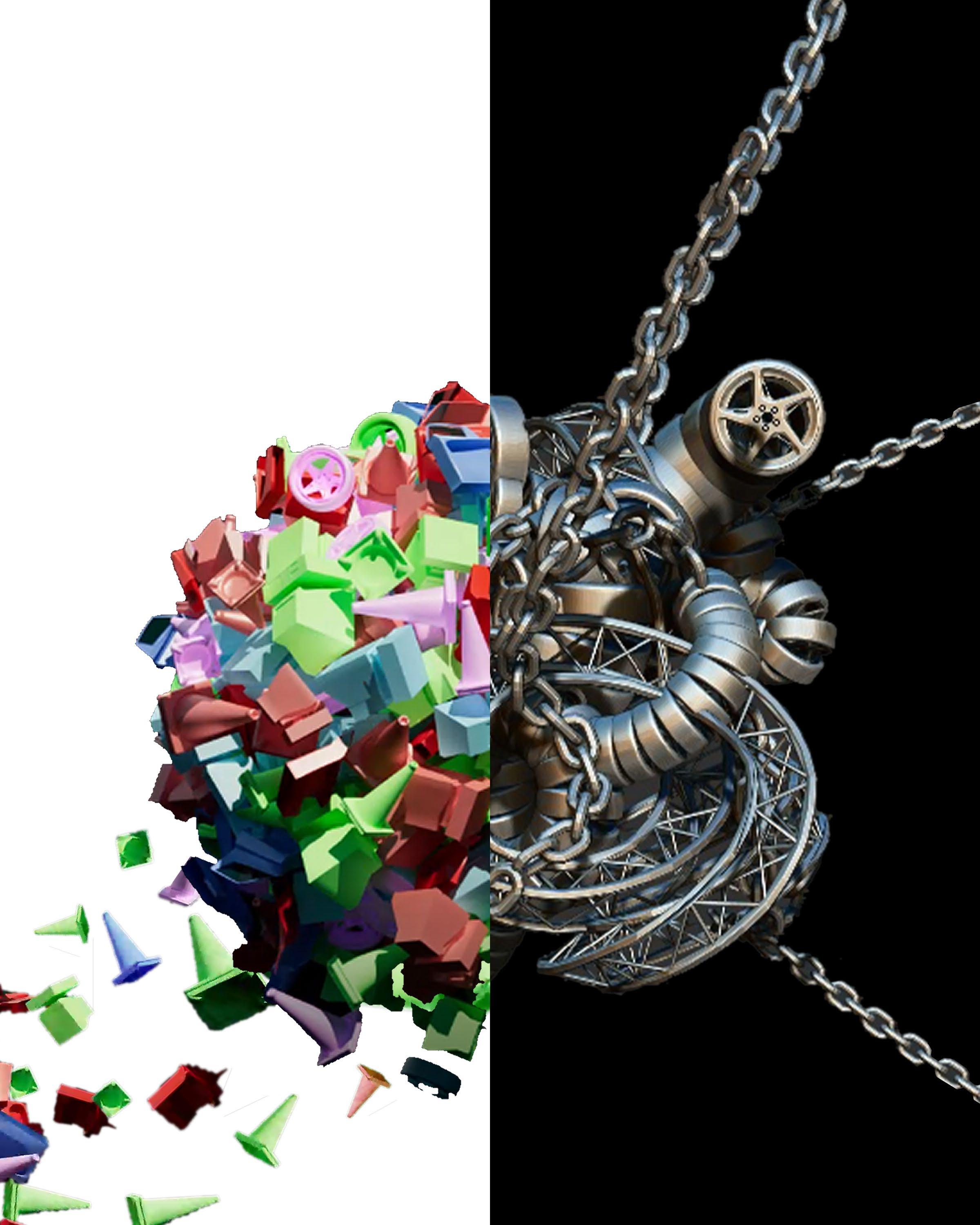
David A Garcia
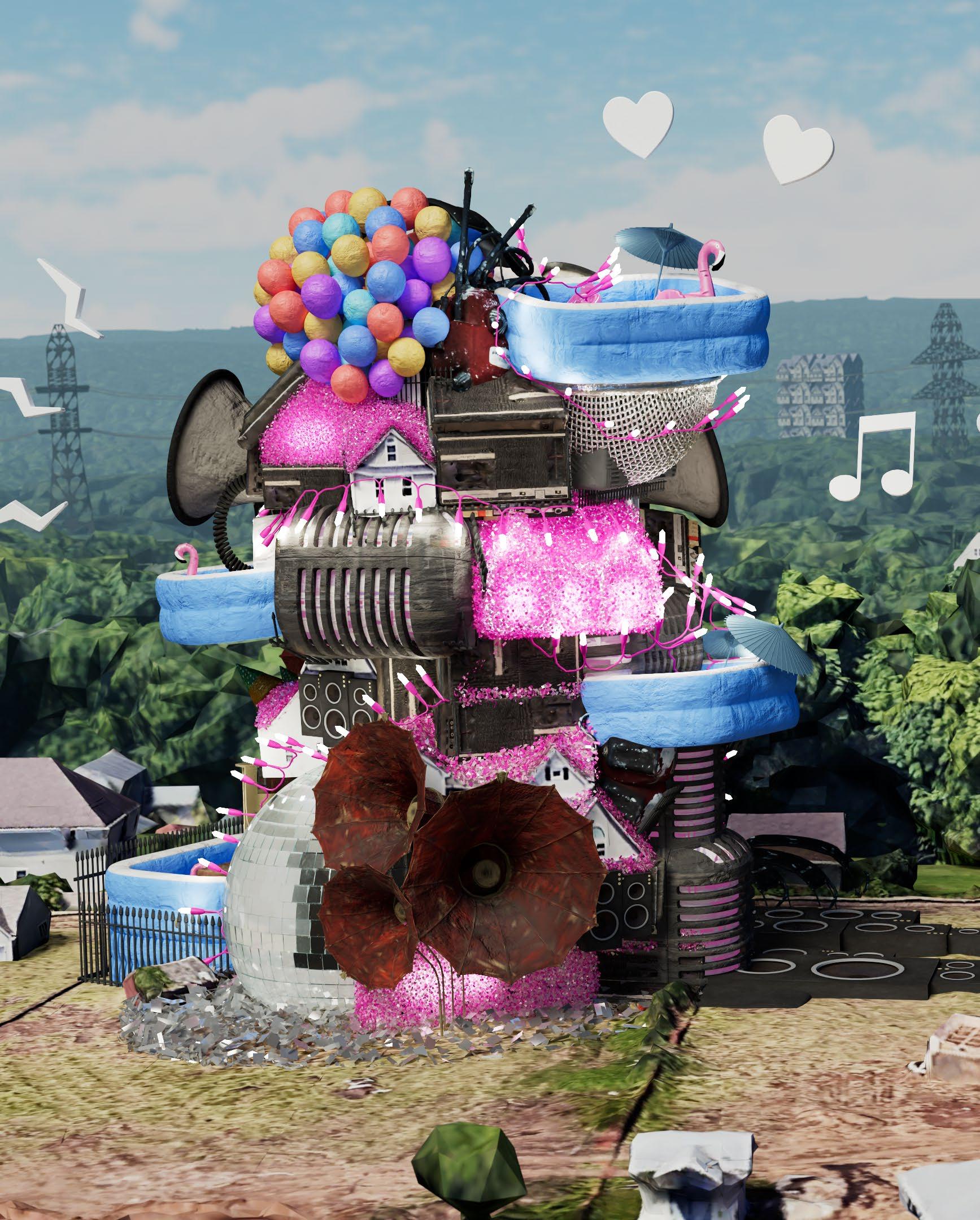
from 20220710_DMNO World.txt on making a thesis
MAKE what you have in mind, THAT is your project. We get caught up in words, semantics, aspirations and then complicate them further when explaining it to your advisor, when they have their own interpretations of these words, their individual interests, and there own visions for your project. You need to tread the line carefully in taking consideration of your advisor’s / colleague's comments and figure out what to ignore, especially if it’s not what you enjoy or not true to your own vision deep in your mind.
Sometimes I want to just say, "I'll make what I have in my mind and that’s what I want to make". And that's simple to say but maybe not realistic, because then you'll just live in your head too long and nobody will understand a single thing about your work because your not taking consideration of others' interpretations and their unique opinions of your project. Summary: don't let your advisor kill your idea if you truly believe in it, but it might mean youre just bad at articulating what your idea even is. So understand that they're just trying to help with what info is given. Their confusion shows you may need to simplify and figure out the true crux of your argument/project.
My problem with my initial thesis idea was that I wanted my thesis to tackle EVERYTHING. Damjan told me I had like 5 thesis ideas in one and that i needed to condense it. It was supposed to be a metaverse film, an actual voting/design software idea (DMNO DAO), a climate change film, an observation/study on dissagreements and decision making, and then of course, the actual design methodology to relay these narratives through it's architectural aesthetics.
It took me until a 1/3 into Thesis' Summer Semester to figure out that I should finally condense it. I'd recommend condensing it into one idea, but I ended up with two simplified categories:
The Narrative, and The Design
Searching for the crux of the project, during the final thesis semester
Climate Change (SciFi Future)
Metaverse (Social Media) Blockchain Voting (DAOs)
Study of Decision & Reactions (Politics)
Object Oriented Storytelling (OOO-ish)
Becareful of clinging on to buzzwords and whatever today's current trends are. You can unfortunately date your project, unless you have something really interesting to add to that conversation, and if that 'something' could only come from you. The ideas will inherently be more rich if it's something you've always believed in, created through processes that you know you're the best at, and if it's a unique argument that you know you can defend. Just make sure you're bringing something to the table, and it's not chosen because you think it's the idea people want (or worse, if it's entirely your professors' idea, with no spin to it). I like the quote from the SCI-Arc thesis advisors that "Thesis is not a finale, but the beginning of your design journey." It sets in perspective that your thesis exploration is something with the depth and personal interest to continue studying far into your career. (Avoid 'pop' trends that will die in a year)
What If A City Was Like Social Media? + Object Oriented
Narrative Architecture
My original film narrative was about an optimistic fictional reality in which we utilized a pandemic lockdown to repair and restore the world against climate disaster. In this reality, the city’s inhabitants debate and make decisions through an online netspace for discussions, proposals, and voting.
I think it's an interesting idea and it feels important, but as I wrote the film, I found myself more interested in writing the debates, decisions and consequences from that online netspace. Therefore, I trimmed out the climate and pandemic focus and zeroed in on this Social Media City that could offer countless narratives and architectural/urban metaphors for socialogical phenomena. How this architecture and urban landscape could be designed then became just as important. As a designer and storyteller, I had to leverage aesthetics to communicate these narratives in compelling and digestible ways. Narrative + Design.
The Narrative
DECISION MAKING NETWORK ORGANISM
The Design
DIGESTIBLE MANIPULATED NARRATIVE OBJECTS
THE STATEMENT from Gow_SU22_Garcia_David_HT STATEMENT
My actual final submission of my "Thesis Words" at the end of the year:
CREATIVE MERIT:
This project originated from an interest into the heterogenous complexities and messiness in our decisions, values and their consequences. In everyday life, I see these experiences most potent in our digital social platforms, but as well physically in the urban spaces around us. So, with this project, I attempt to collapse these concepts into a medium that I can express aesthetically, through architectural objects and cinematic narratives. These cinematics and accompanying architectures aim to embody these messy and complicated phenomena, but through digestible and entertaining ways. The film’s setting and its architectural characters become these surreal assemblages of familiarity that operate as narrative objects to orchestrate the values of these decisions and reactions. The series performs as a piece of appreciation, or expression of my fascination towards our decisions and inthe-moment reactions that happen during and after the fact.
FILM DESCRIPTION:
In a reality different from ours, an application opens and projects the city as a digital social platform. A sort-of social network where an entire city designs and pieces itself together through discussions and decisions, inquired from prominent groups to individual nobodies. This application is called DMNO, the Decision Making Network Organism. A living, ever-changing city, aggregated through episodes of messiness, disagreements, collaborations, and consequences - experienced through the aesthetic reflections of these multifaceted value systems.
This idea-categorization method was adopted from my advisor, Jeremy Kamal. It was a useful strategy to divide the thesis into different merits, concepts, processes, etc
ARTISTIC STATEMENT:
This film wants to explore the diversity, complexity, and messiness within our values and decisions. Maybe your ideals are the best, maybe they’re not, and maybe they can coexist with other contrasting ideals, maybe they can't. Some decisions will provide benefits if you give it the chance to grow, and some really will fail and have made a negative impact, and those imperfections are inevitable. I can not be the one to claim certain decisions are the best, but I do believe there are interesting stories to be told about the complicated messiness and dramas that arise from these decisions and values. What it is not, is a call for centrism or to be apolitical, but really, to provide an awareness or to share my appreciation of the complexities of these processes. These social phenomena are complex and layered. I want to explore and express this nuance of our existing world, digital and physical, and hopefully present it in an engaging and enjoyable way.
KEY WORDS & CONCEPTS:
DECISIONS REACTIONS CONSEQUENCES MESSINESS CACOPHONY AESTHETICS DIVISIVENESS NETWORKS SYSTEMS AGREE / DISAGREE DEMOCRACY DISCUSSION PROTEST MULTIFACETED IDEALS/ VALUES PROCESSES IN-THE-MOMENT
THE STATEMENT from Gow_SU22_Garcia_David_HT STATEMENT
My actual final submission of my "Thesis Words" at the end of the year:
DESIGN PROCESS:
The process to design this speculative world in a concise short film requires a specific architectural method of storytelling. The operative technique is an object-oriented design methodology that focuses on clear, concise, but aesthetically interesting, storytelling descriptions. The design approach can be summarized as “Digestible Manipulated Narrative Objects”, concerning aspects of aesthetics and their ability to convey narrative in an compelling way. I believe this design approach will be a valuable way to convey a digestible cinematic story through visually complex and novel architectures.
"NARRATIVE OBJECT" to me, is an object/ thing that relays a story. A good narrative object expresses a clear narrative, history, and reason just within the object itself, and to a common consensus of the audience. These are things like a Nike logo giving off the energy of athleticism, quality, or coolness because of the history embedded into that symbol. Balloons exuding an energy of playfulness, party, or celebration, or the color gold suggesting ideas of royalty, luxury, or beauty. Using these
symbols to work towards a legible story is the purpose of the narrative objects in my work. I use these - architecturally - to produce form, space, and storyline. The specific process to attractively operate these relies on its aesthetics. The mechanisms I am proposing to achieve this are Digestibility with Manipulation.
“DIGESTIBLE MANIPULATED” design is difficult to describe in written words, rather it is the designer's job in producing intriguing aesthetics through legible, distinguishable designs that are also altered and tweaked enough to understand that aesthetic moves have been tastefully performed. Good digestible objects usually happen to be the simplest and most banal of objects. When things are common in everyday life or when things become clichéd, that is when something becomes a digestible object to a common consensus. As designers we can then attempt to hone the use of banality and cliches to allow one to create complex and more interesting transformations that provide a sort of novel aesthetic read while providing that clear simple understanding of what its
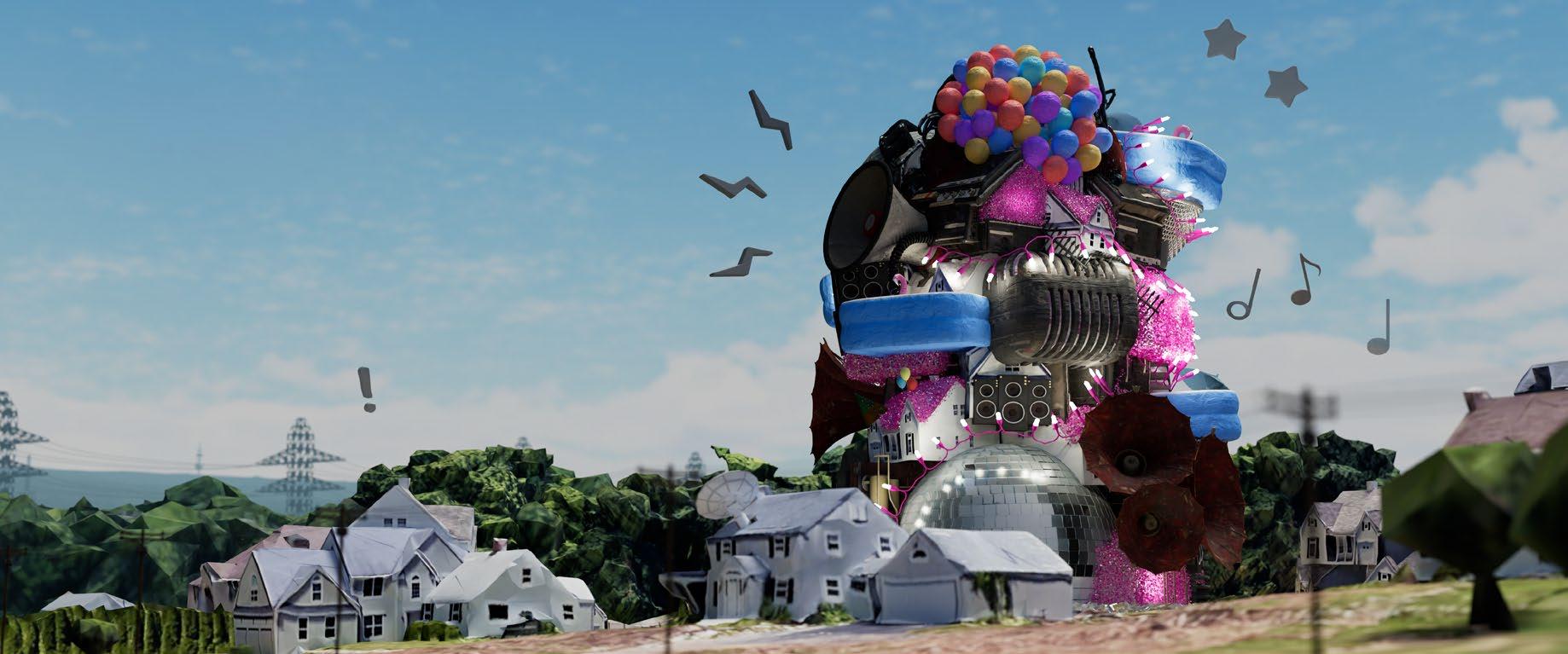
made from. This is why the manipulation of the digestible is so important. The familiar objects go through alterations and transformations, performed often enough so that they become new objects, or 'designs'.
"Digestible" is the sense of familiarity and clarity, "Manipulation" in the sense of defamiliarization and craft. They sort of combat and contradict each other, and it’s up to the designer’s ability to work within that paradox and discover where on the spectrum works best to convey the idea or narrative to you and your audience.
This framework is the sort-of mantra that I use when creating the film and the designs within it. I try to explore this idea with the most potency through the use of literal objects assembled or clashed together in architectural ways to assist the narrative. Things like huge gears and faded brown tones are used to convey a feeling of
“industrial” or “mechanical”, or the use of oversized balloons and inflatable pools give an idea of some playful party addition. Cinematic strategies also contribute, like using a familiar google-maps setting mixed with a sort-of social media emoticonreaction system to create this new fictional software application. I envision the entire film assembling itself through a collection of these narrative objects, both in the literal architectural objects as well as the separate cinematic episodes that themselves become narrative objects to piece together this world.
I'll start with the design methodolgy. I feel like the architecture & design audiences would be more interested in that first.
DIGESTIBLE MANIPULATED NARRATIVE OBJECTS

PEOPLE LOVE OBJECTS
In many designers current exploration into non-modern and novel architectures, full of different complex designs trying their hardest to look as complex and layered as they can, the way that a project stands out, seems to me, to rely on its Objectness. The other complex architectures that just rely on complexity itself, end up being this kind of mysterious object that may “wow” you at first, but provide nothing to further sink your teeth into. There’s not much to digest in those designs, and seeing student work here in SCI-Arc, the interesting visual complexity is raised to a max, but most of them don’t seem to be
eye-catching and, more importantly, eyeenduring. The designs that I feel achieve that level of visual complexity, along with deeply intriguing it’s viewers, always seems to be the most 'Objectal' works. (If that term isnt coined, how do people coin a word? I just want more people to know that word is all) This is not architecture that just follows it’s diagram, nor architecture that just molds into a big obviously known object, but is a phenomenon where there is extensive manipulation and articulation paired with the familiarity and the stories that an object contains.

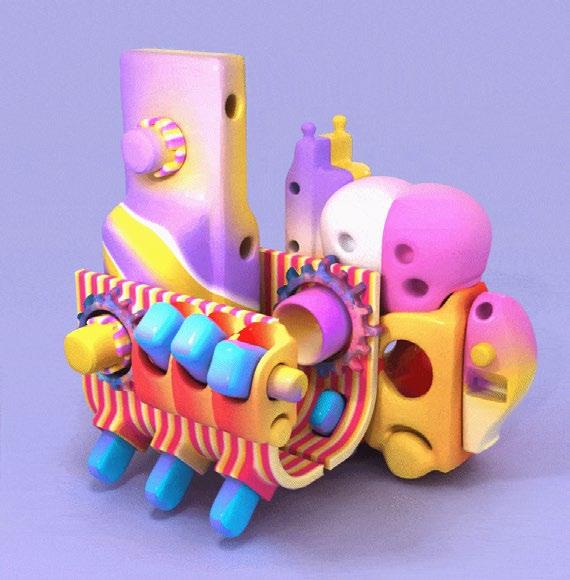
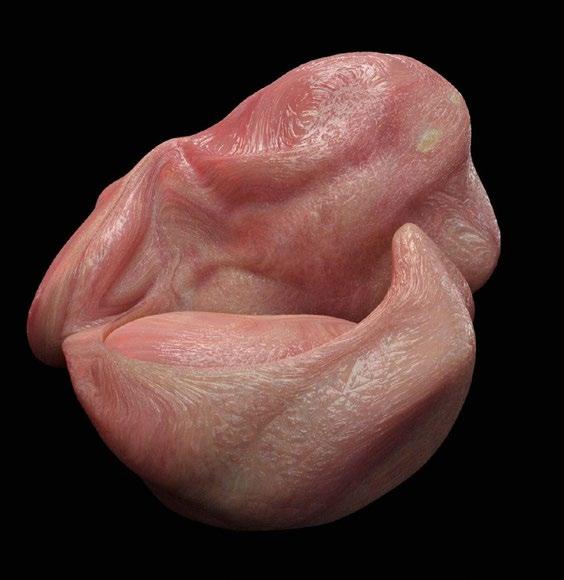
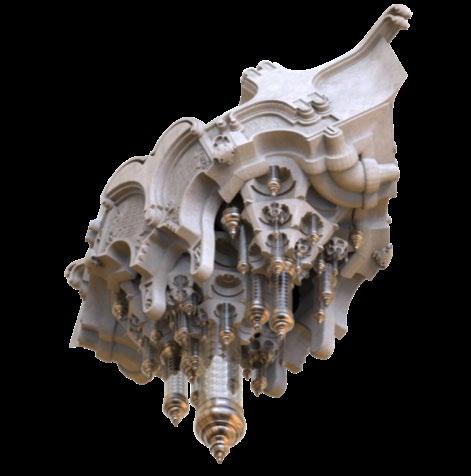
OBJECTAL
adjective
1. Having the form of an object or objects; pertaining to the physical form of something; material
2. Concerning the cognitive representation of an object outside the self.
EXAMPLE QUOTES I'VE HEARD FROM THE VIEWERS OF A OBJECT-ORIENTED DESIGN:
“Oh that looks like a heart”
“Oh that looks like a zipper”
“Oh wow that looks crazy”
“Haha thats looks funny”
“Ha it’s like a — mixed with a —“
“I see you created it out of —“
“Cool, I like how soft it looks”
“Wow it’s very cute”
“Wow it seems heavy”
“Reminds me of a potato”
“I see the symbolism of the trees”
“I like the use of the primitive shapes”
“It’s like a river”
“Feels like an oasis”
“Oh look at that twisty part”
“Ooh Legs!”
"It looks like it's gonna fall apart"
"Oh I see you copied Frank Gehry here"
"It has hints of - in it"
"Oh I see the gable roof in there"
WHAT IT'S NOT:
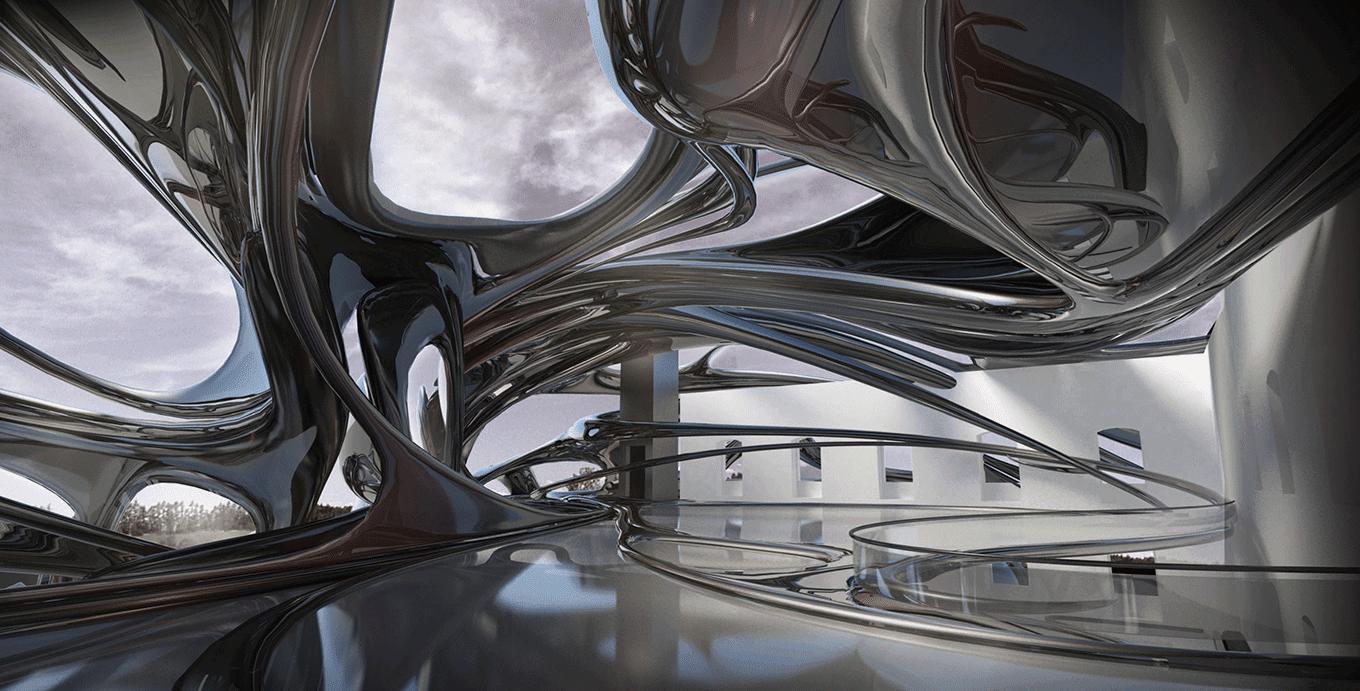
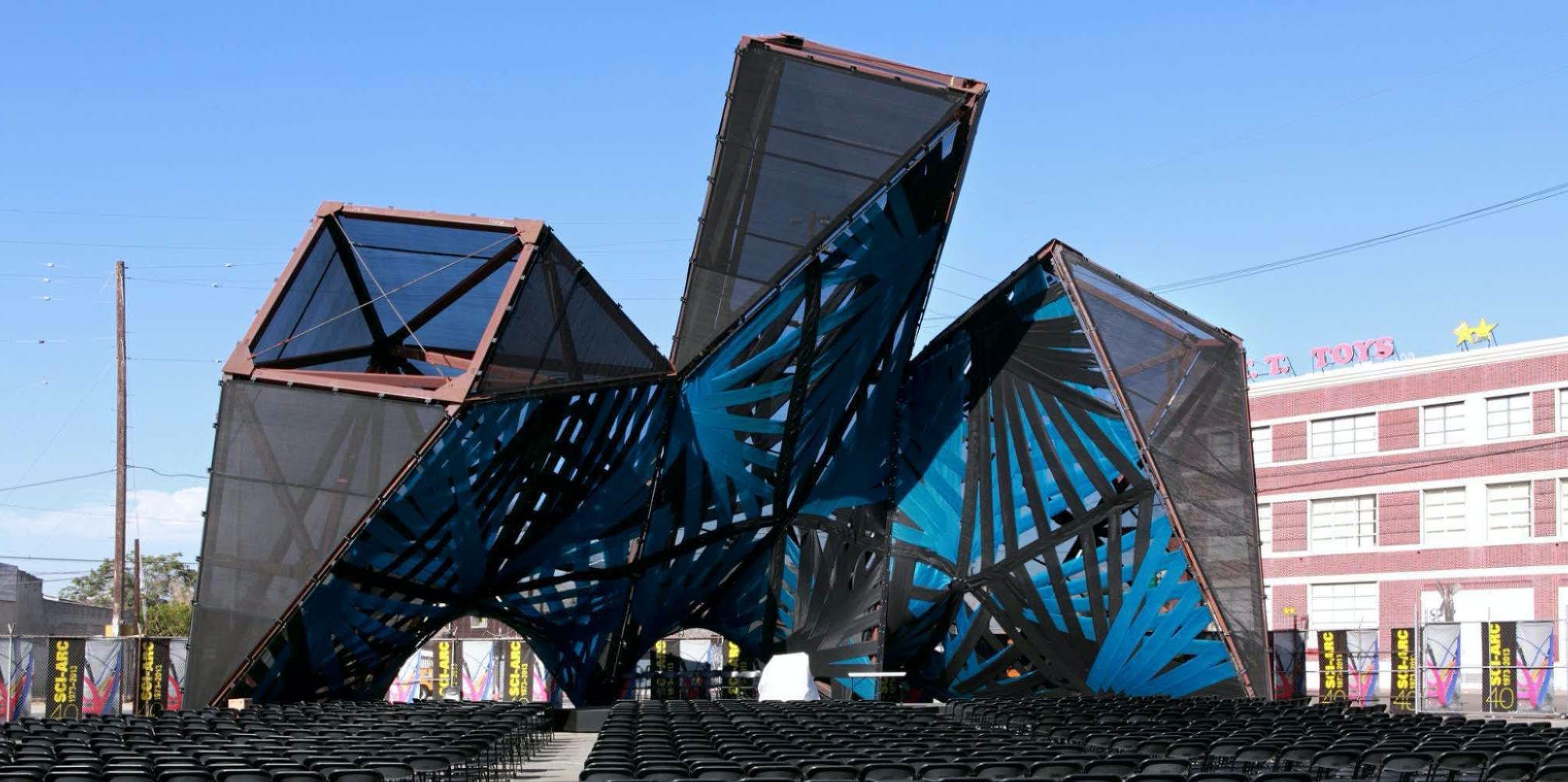
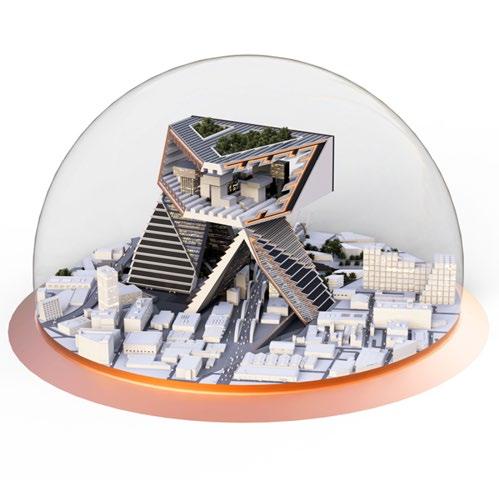
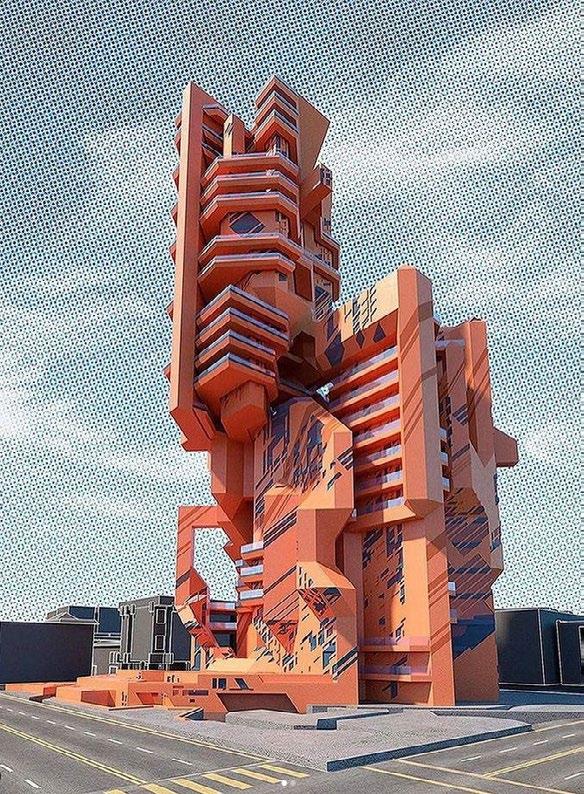
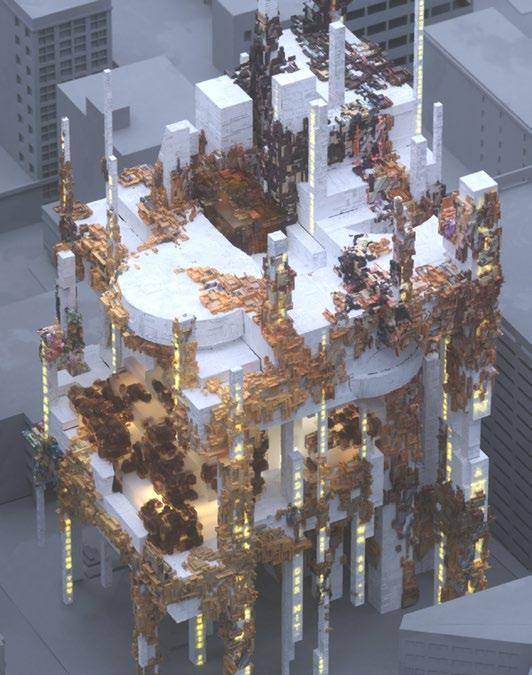
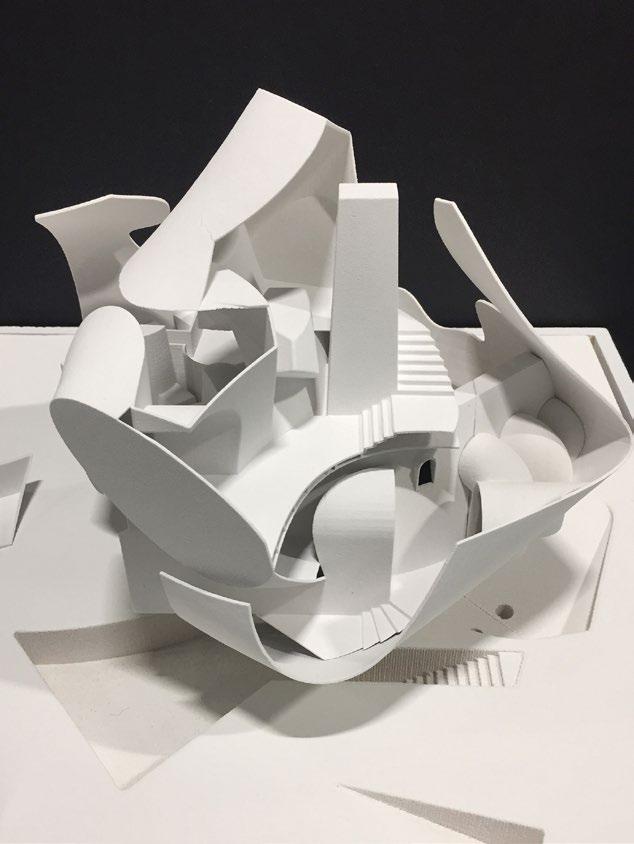
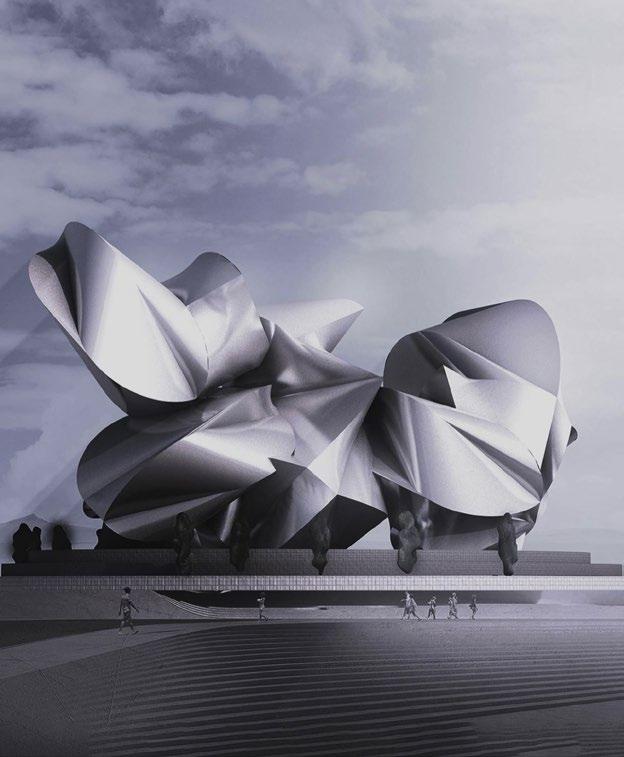
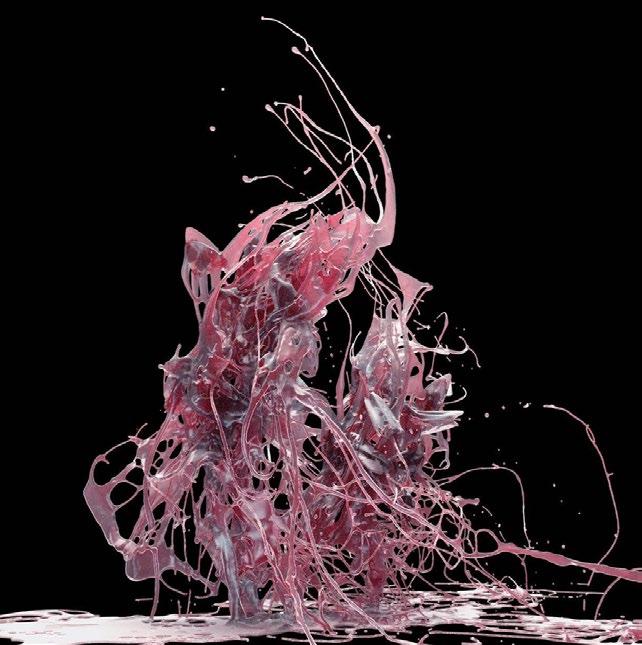
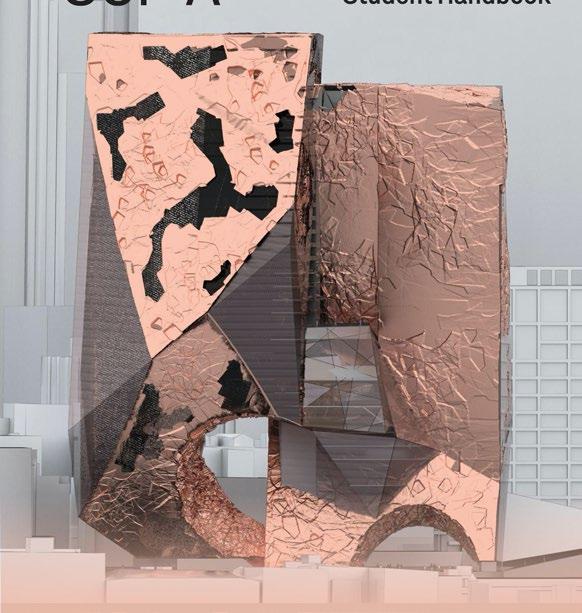
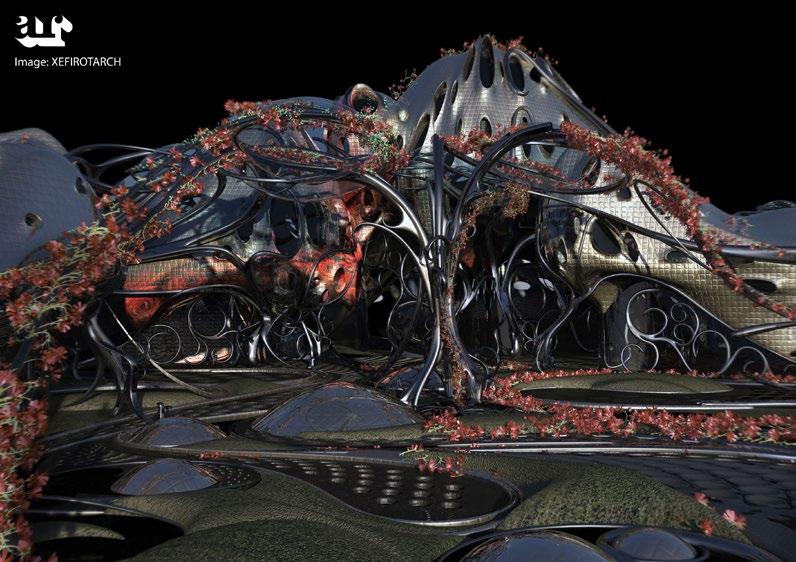
These are project that I'd consider "Mysterious". I don't think it makes them bad, but I notice that there's not much to sink your teeth into... you can't really decipher what you are viewing. too manipulated.
CLOSE BUT NOT QUITE:


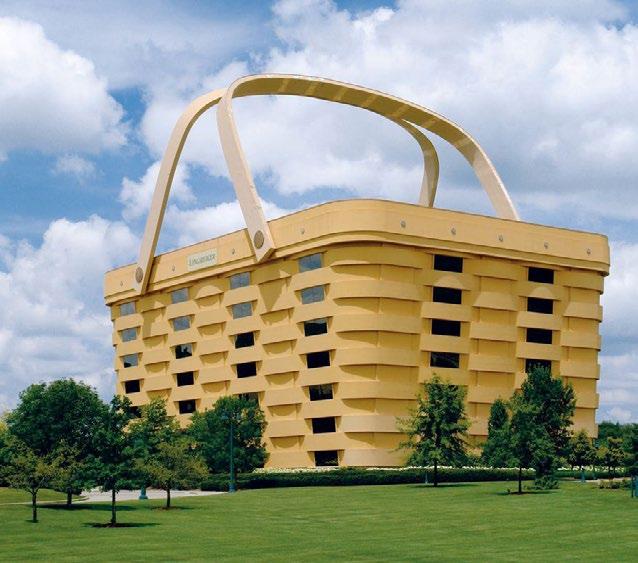
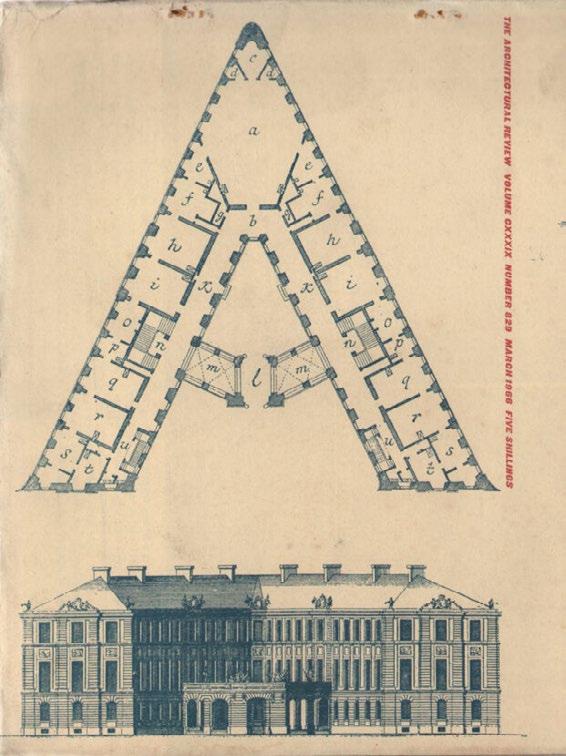
too digestible.
These are "Objectal" but, I think, are not done tastefully. Either it's when they manipulate the elements wrong, or they don't transform the objects enough (too literal, too much spoon-feeding)
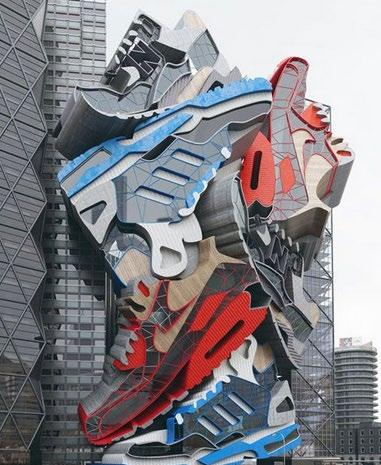
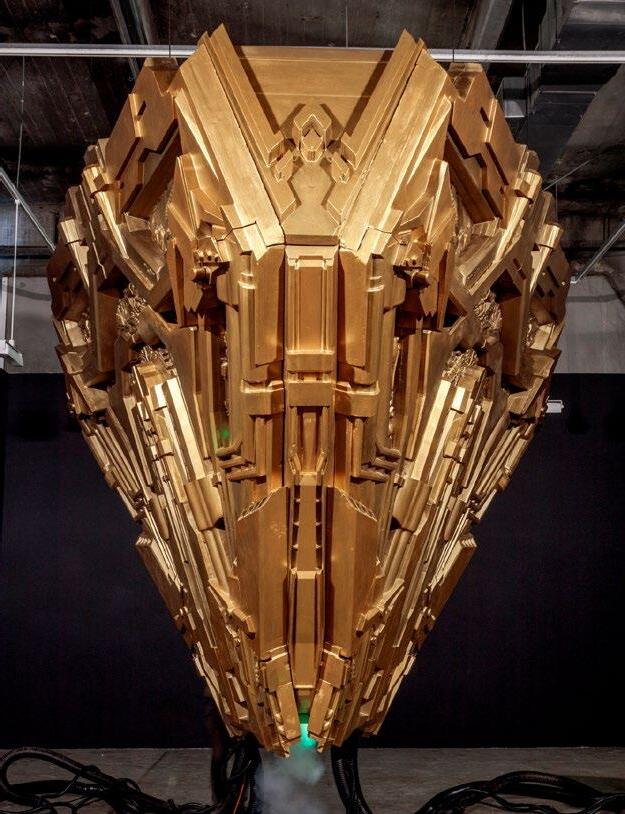


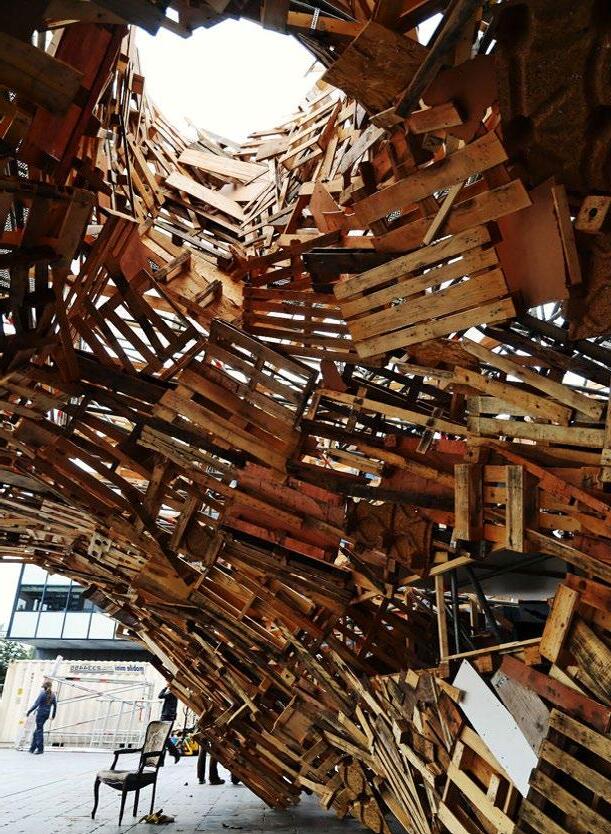
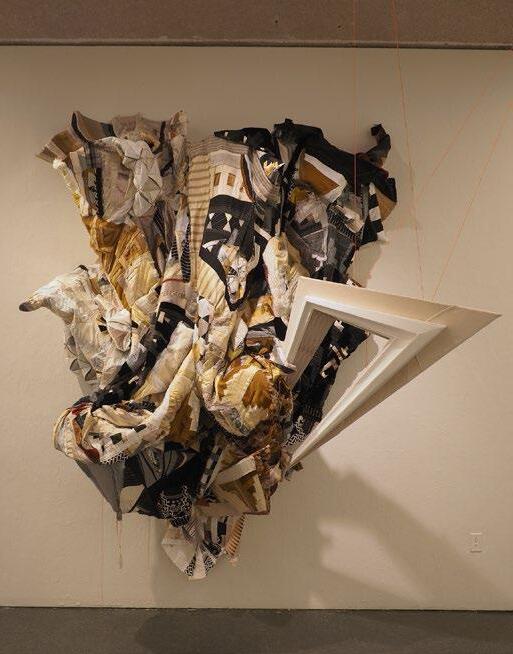
PRETTY MUCH THIS:
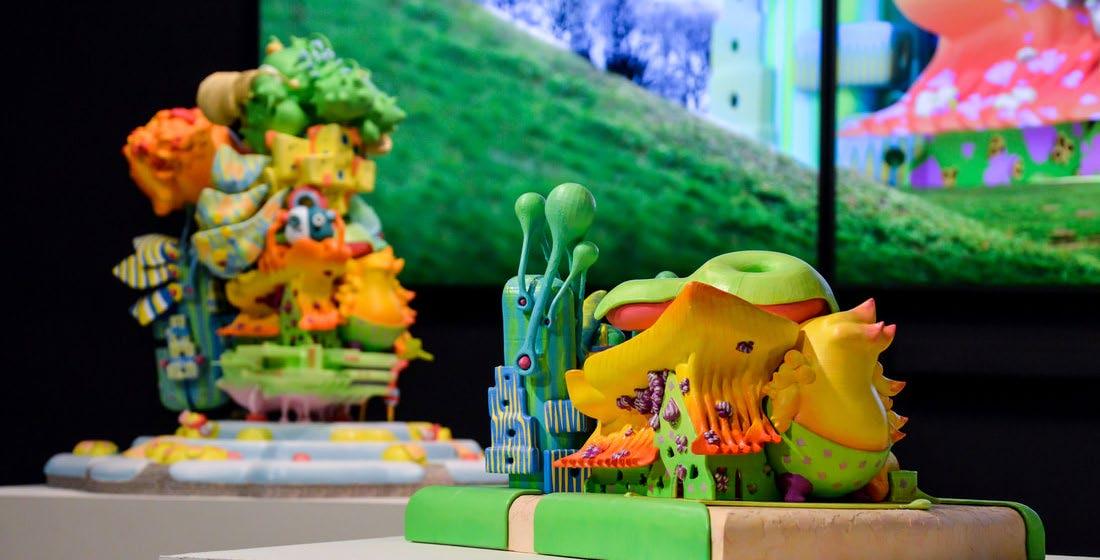
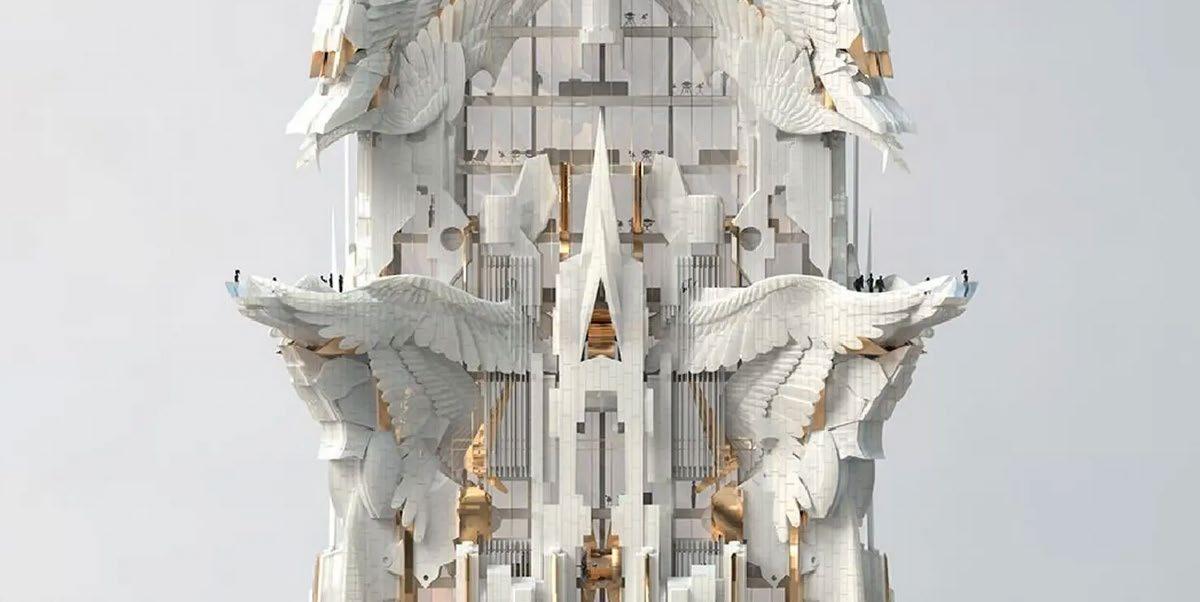
These are projects, I believe, are tastefully "Objectal". You can really digest what you are viewing and you can likely decipher concepts/narratives just through it's aesthetics. They carefully balance being literal while transformative enough to feel like a novel and tactful design.
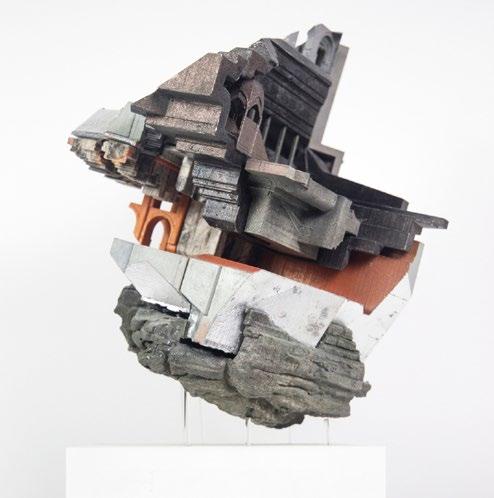


Digestible enough and manipulated enough.
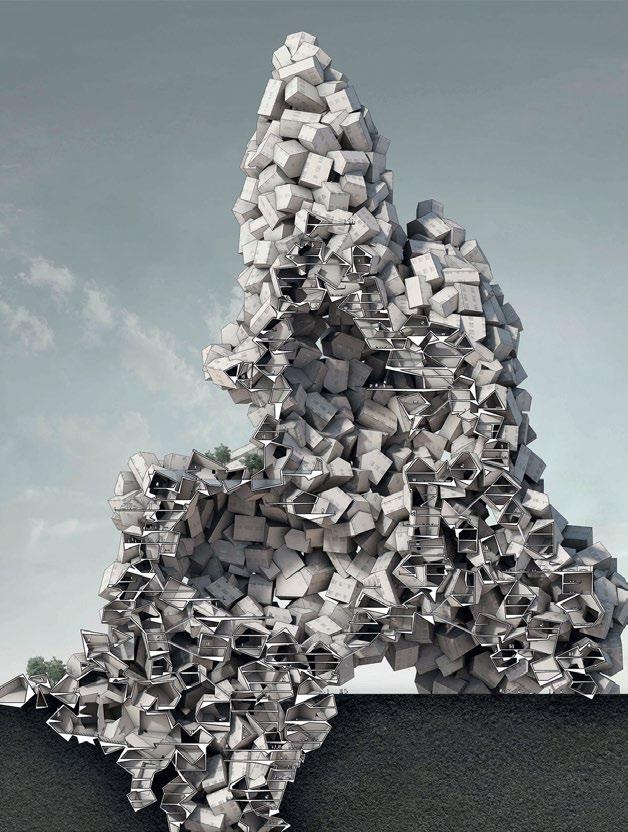
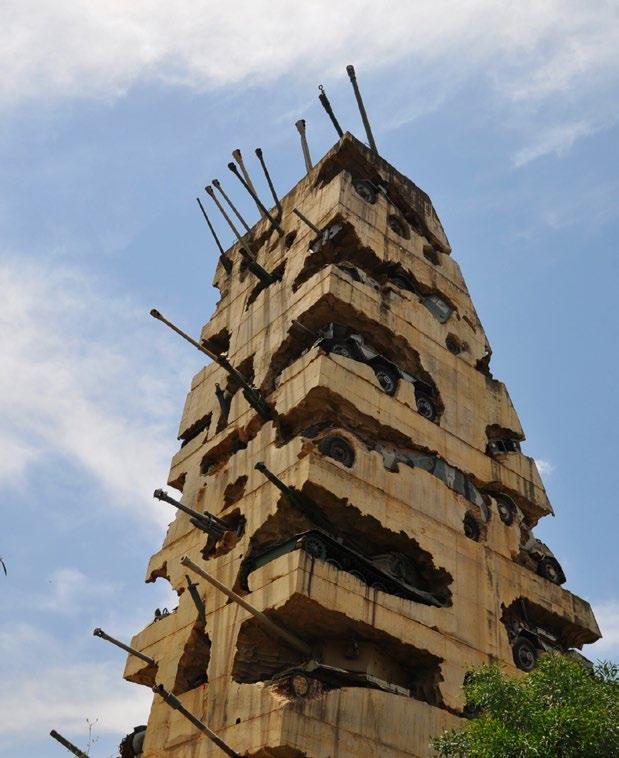

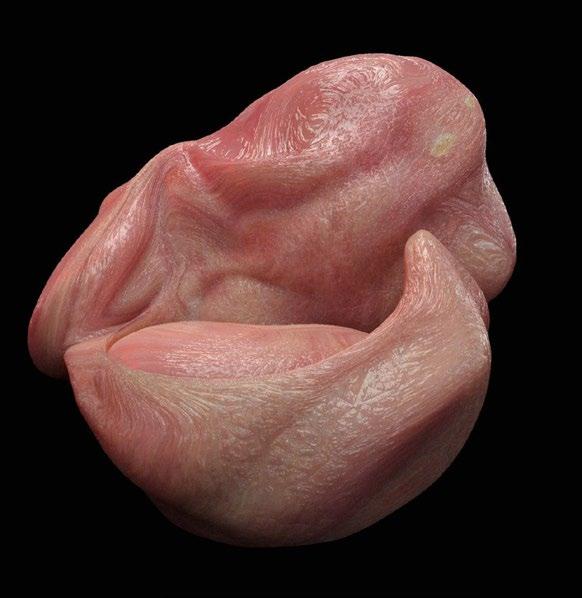
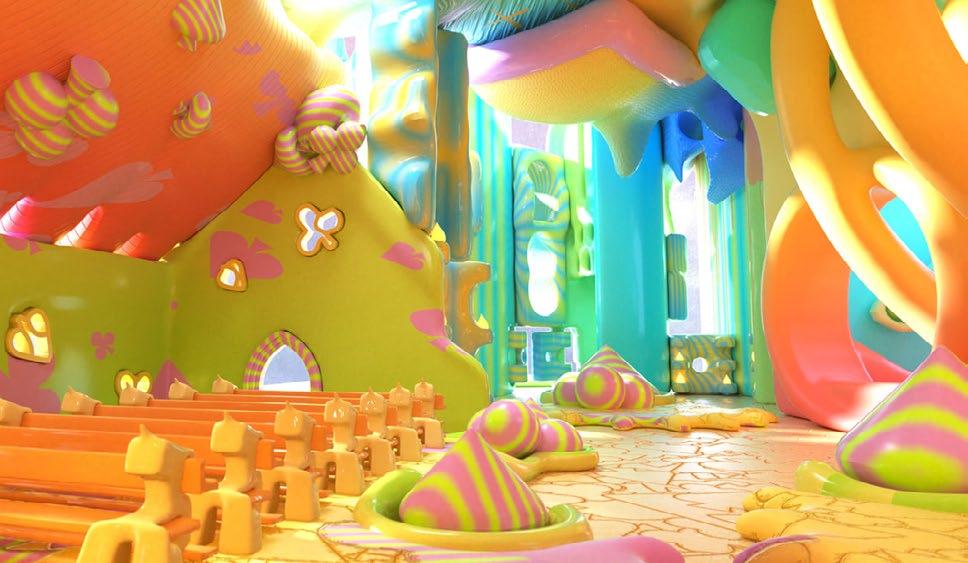
"Object-Oriented" Architectures from myself
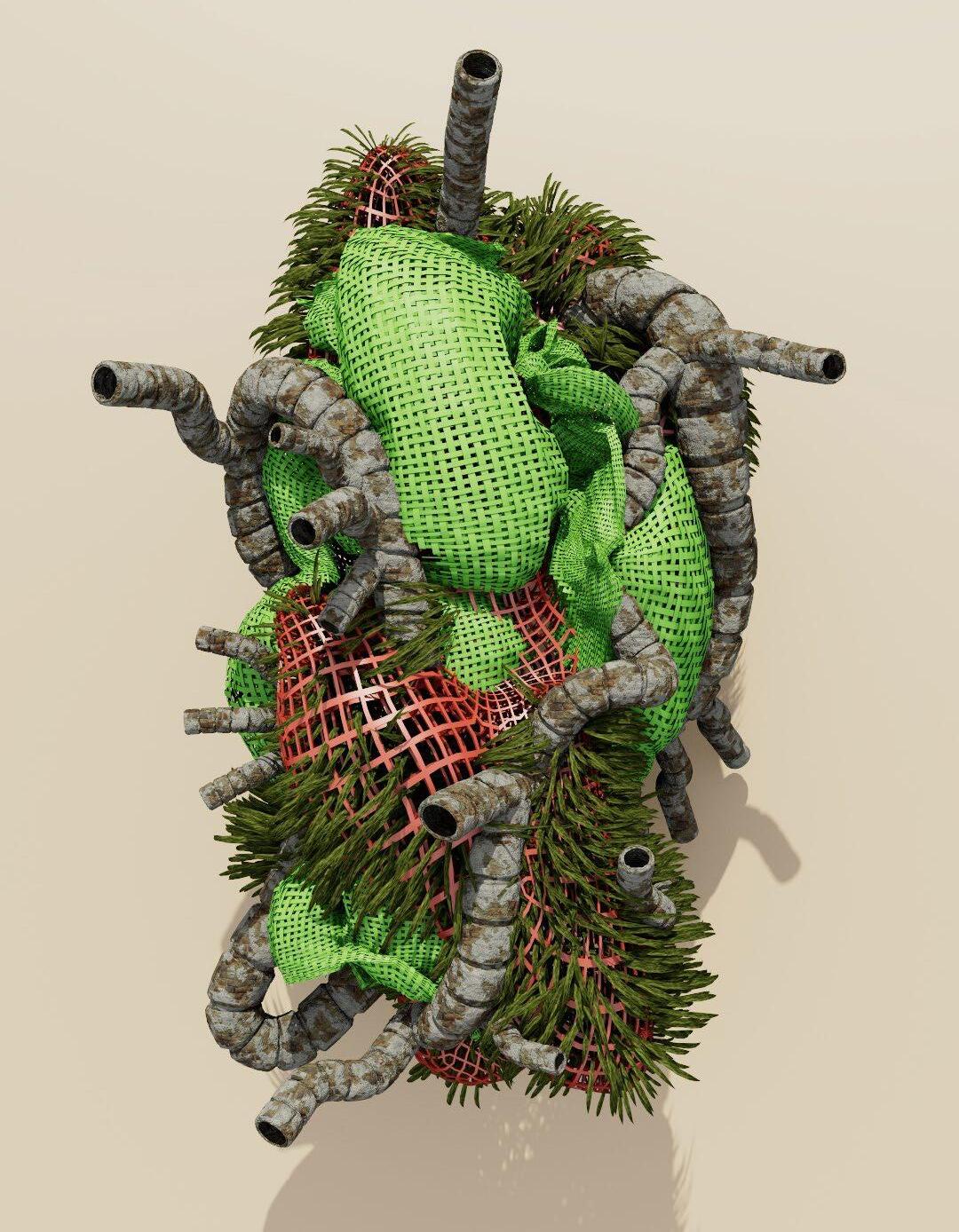
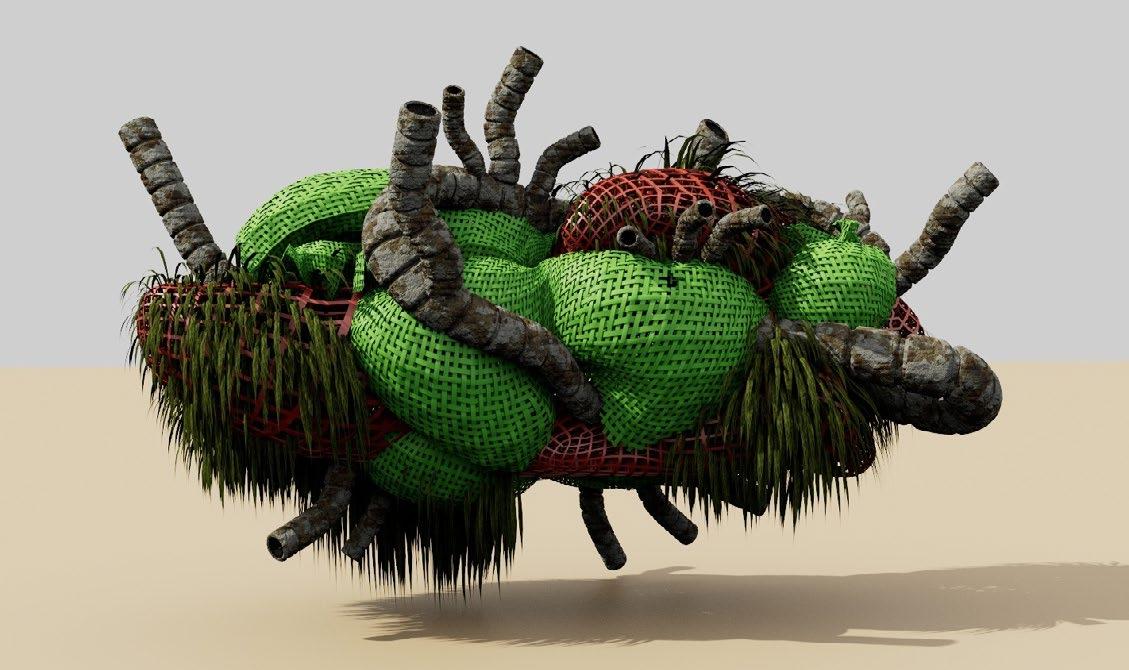
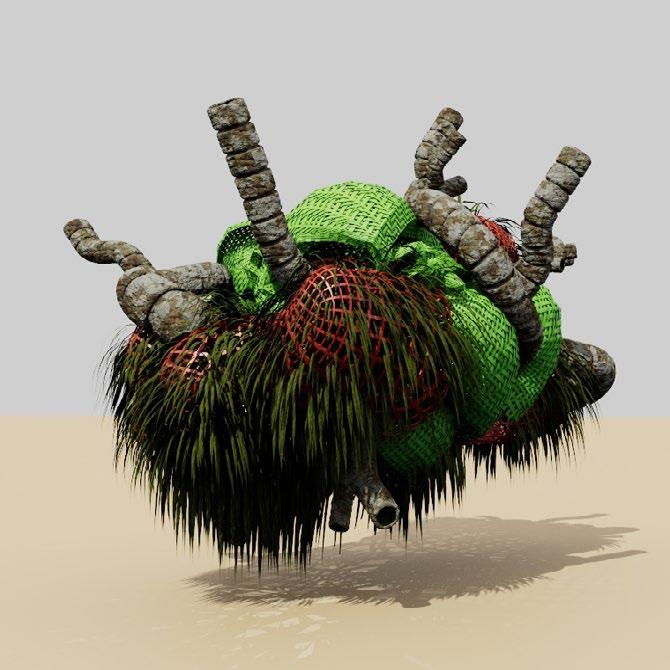


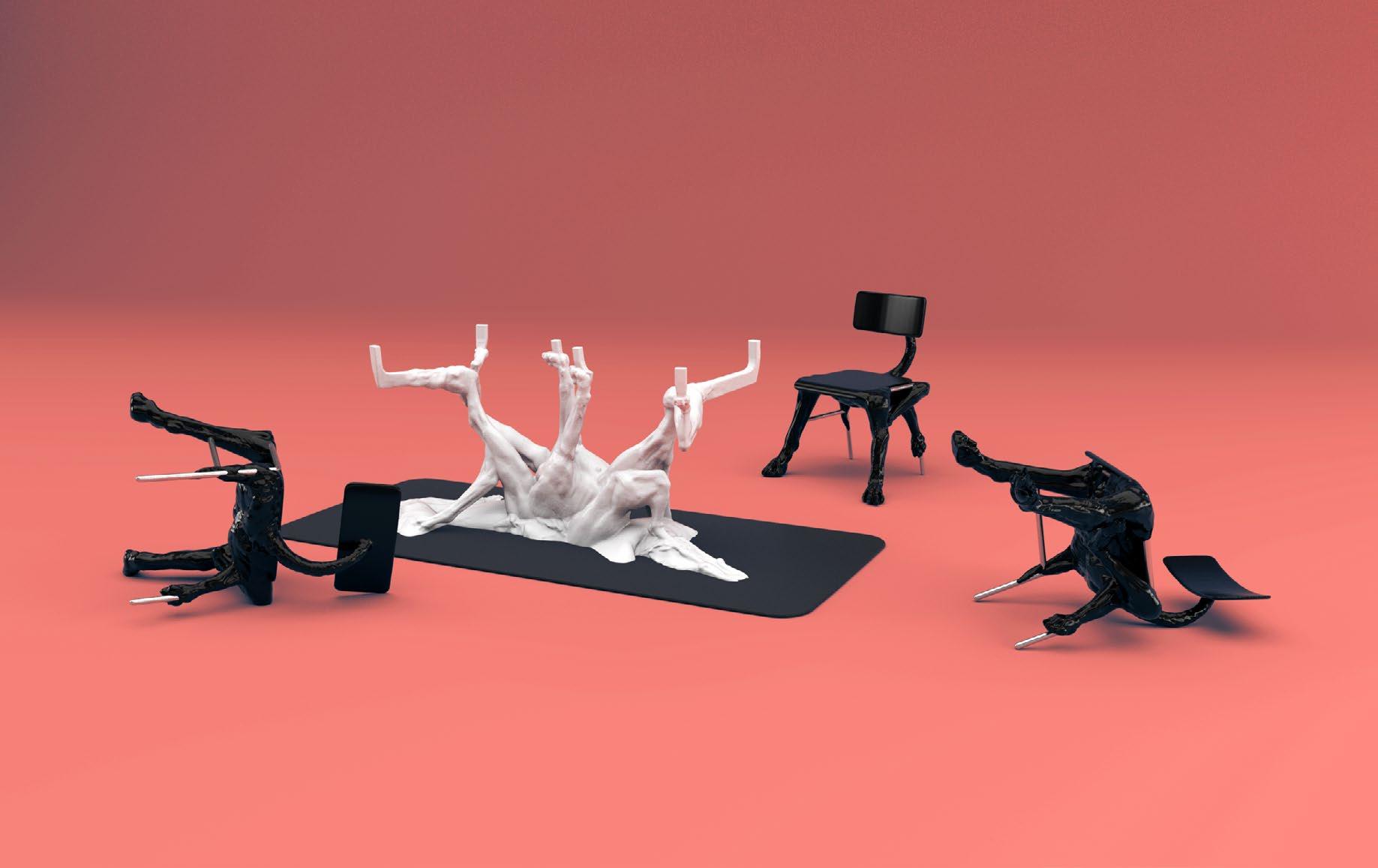
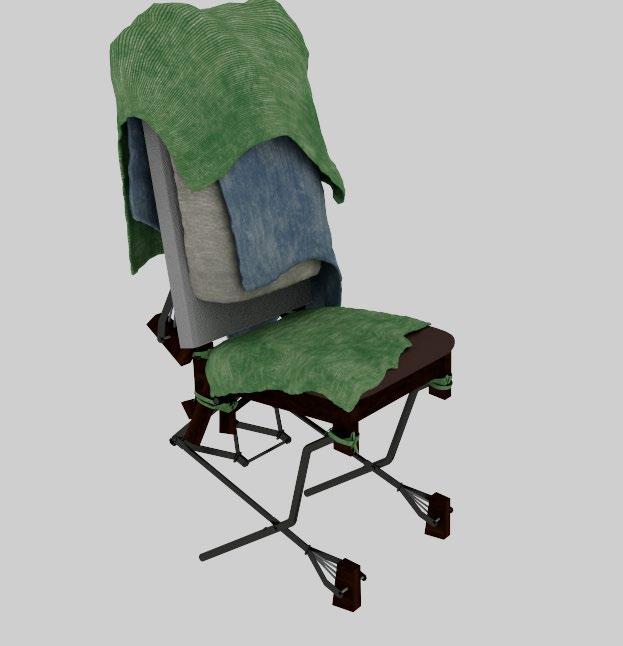
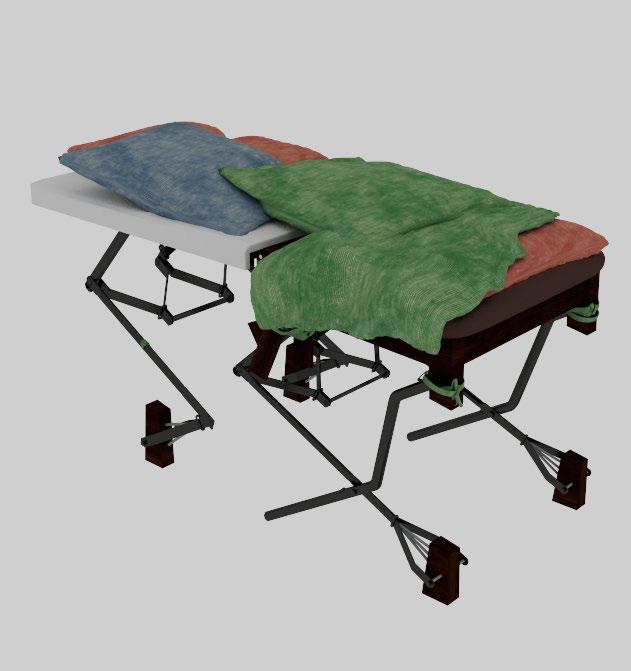

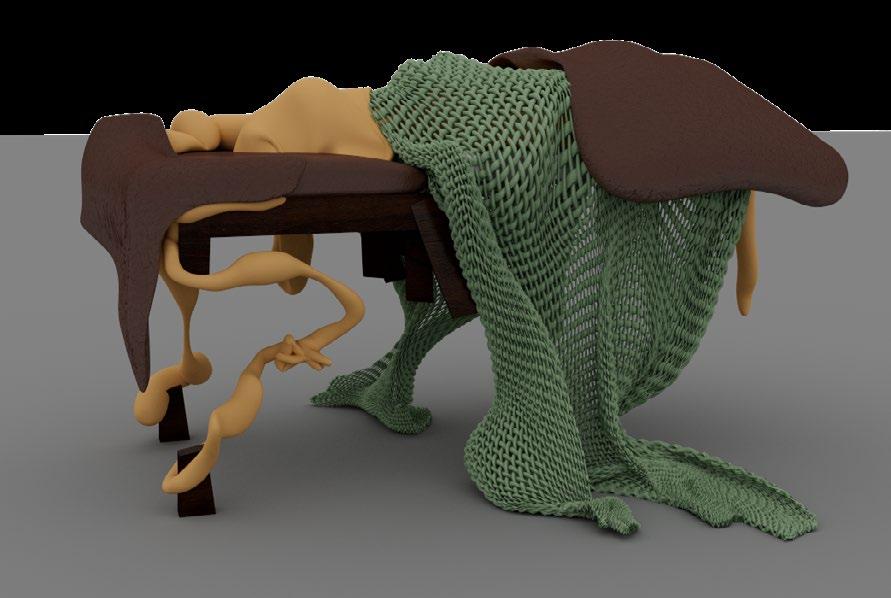
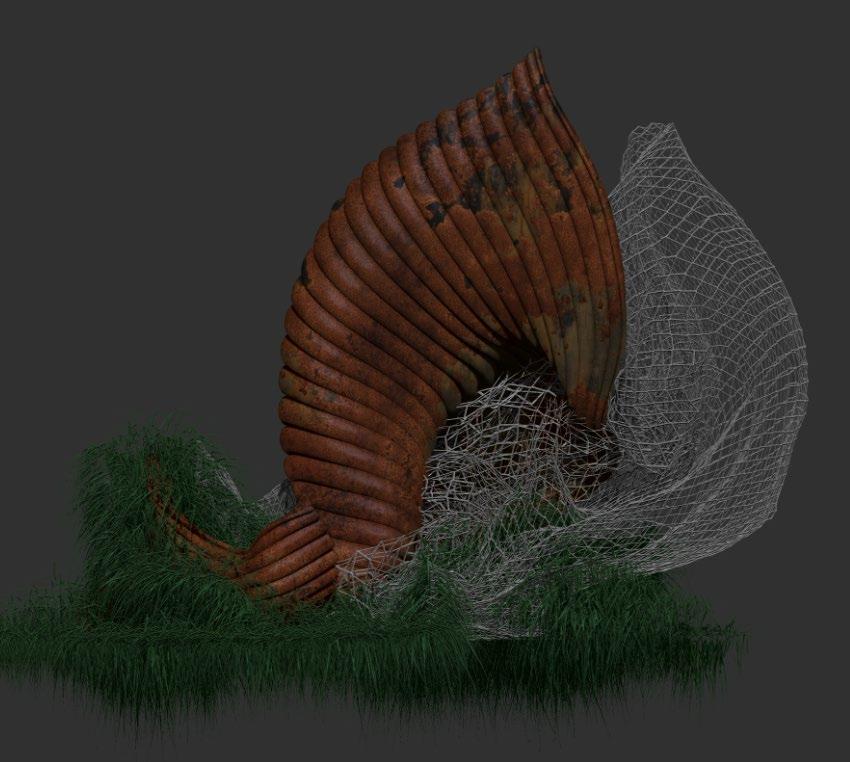
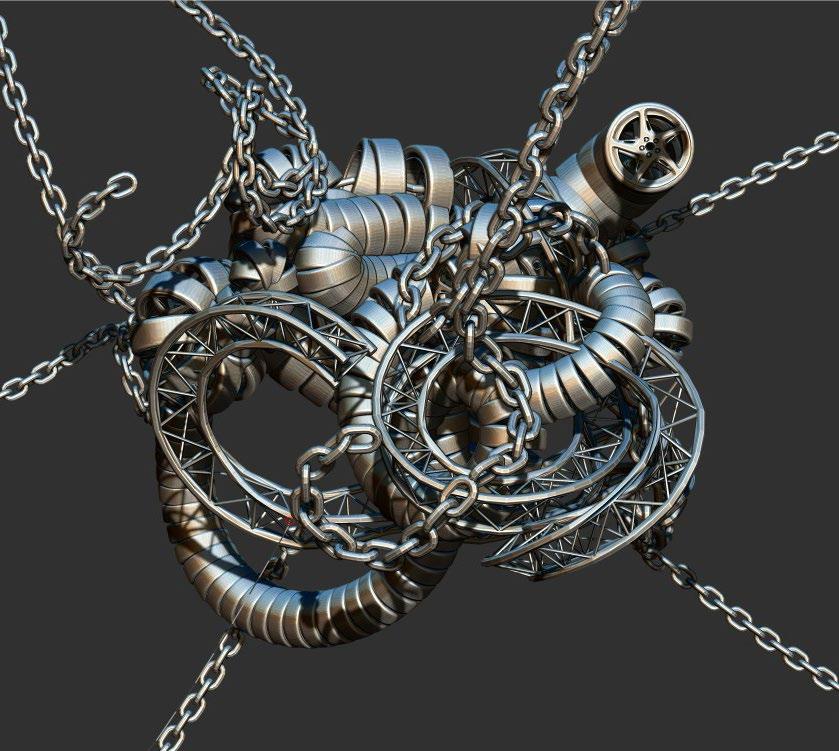
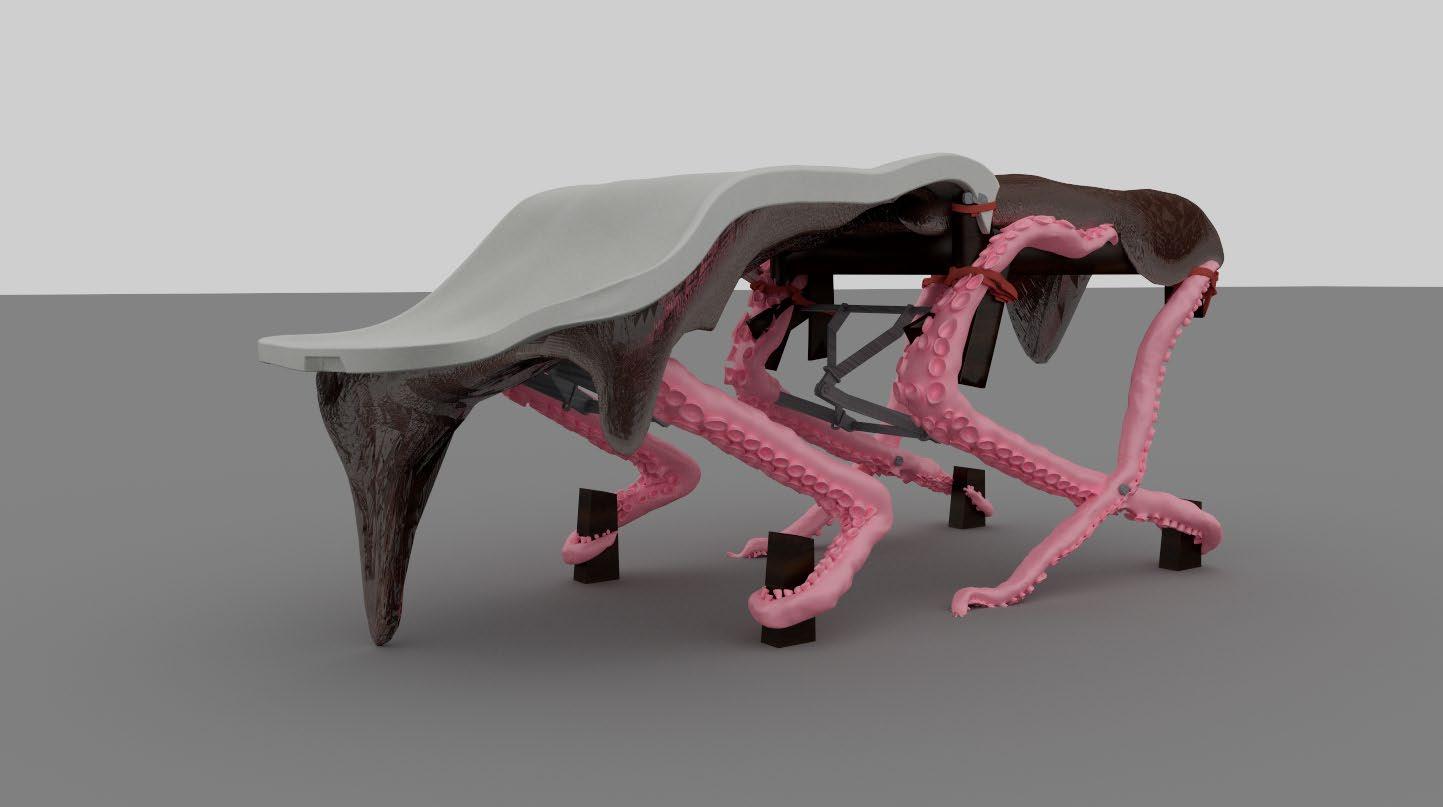
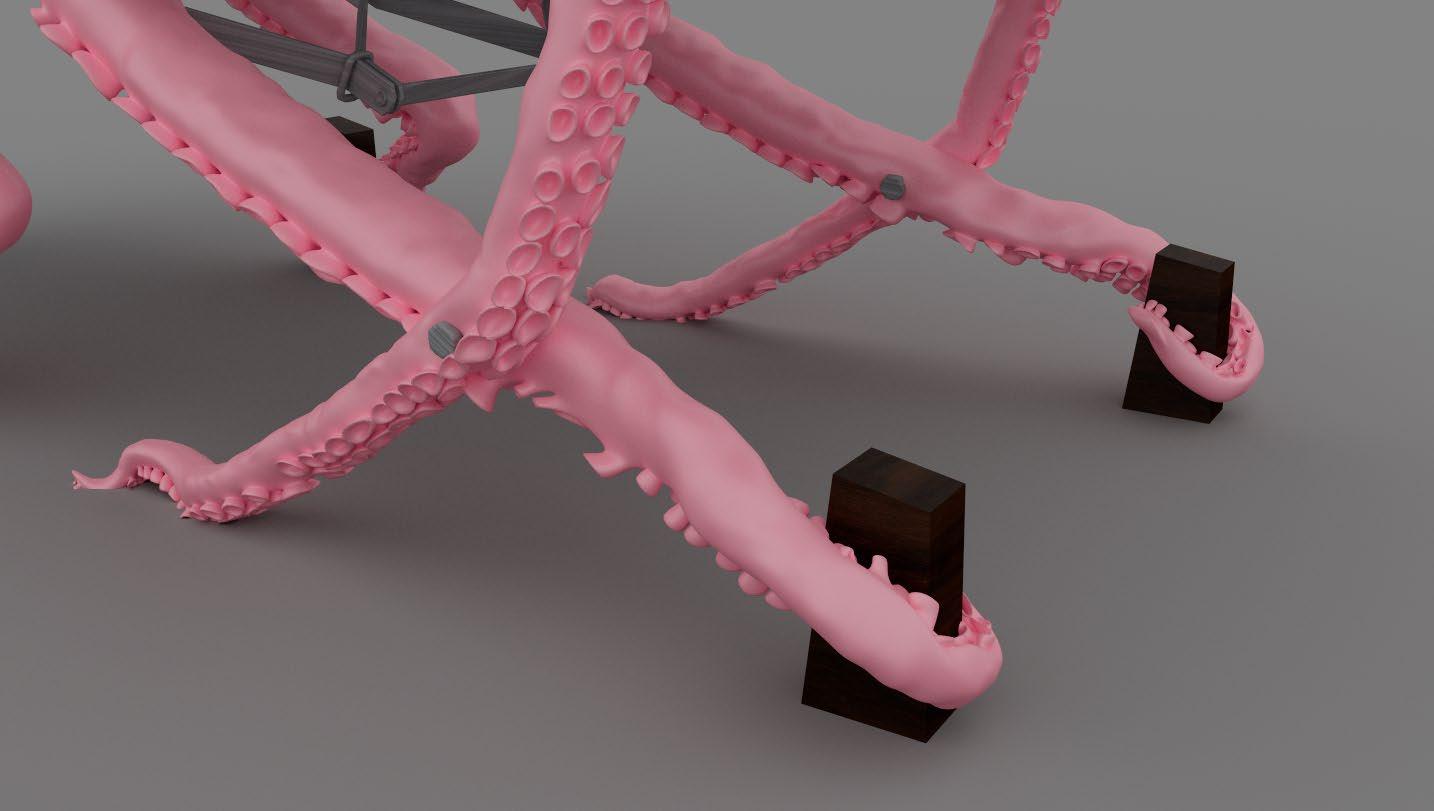

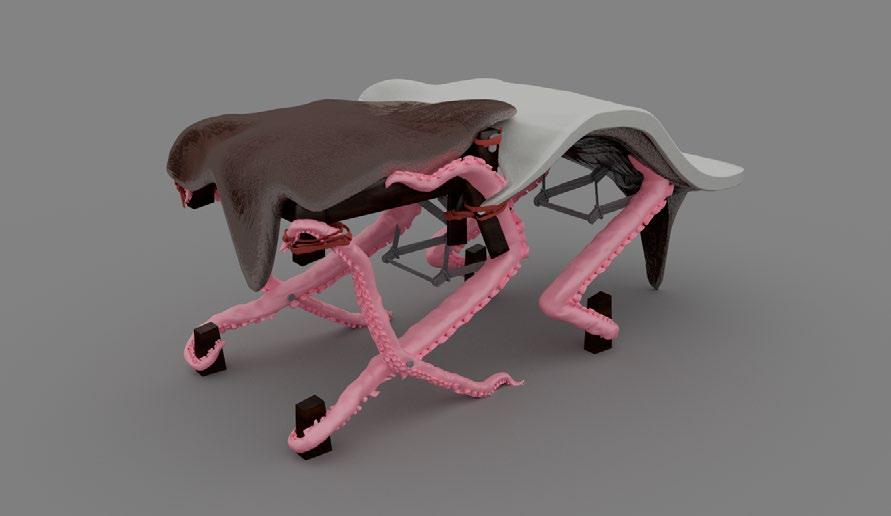
THESIS PREP IDEAS: "OBJECT" AS MATERIAL. MATERIAL AS STORYTELLER.
To create novel form, aesthetic and culture while moving away from form that is just this white-clay that’s molded, parametric or sculpted. I’m venturing to make form that is driven, or “imaged” (cladded or built) by specific objects, things, or materials. This allows meaning/depth, architecturally and social-culturally because of the object choice. It is a fossil; a new object that morphed from something else in history/culture, pieced together with other objects and now tells a story as a “corpse” or a “Frankenstein Monster”.
This just allows another way to tell a story at the large scale and at the closeup scale. I want to avoid moments when seeing a building from far away and the form is absolutely beautiful, but up close, it’s just your usual bent aluminum, stucco, concrete, or 3D printing that’s used to just emulate or quickly solve the fancy form that was designed. I think this extra intrigue of an overall beautiful formal parti paired with a provoking close-up material/ tectonic/object system, is a powerful piece of storytelling.
I want Object-Oriented but not necessarily OOO Architecture. I'm kind of against some contemporary OOO architectures that are about clustering a bunch of random objects as a blank white mass and calling it a day.
But those OOO designs have been very inspiring when thinking about digitalonly or "paper" architecture thats more about the narrative than realism. There's alot of depth in that I think. Where the architecture is molded by a clay (clay being the objects/things), and those
objects would have intrinsic meaning to what the building is about. It creates novel shapes while imbedding meaning into materiality / formal strategy. It really can be the material of a digital space. When any physics or real-world-material is possible, what does one choose as their “material”? Why choose metal or wood when almost everything is possible? Or the obvious freedoms of environmental factors, gravity, and structural factors? Would the ‘materials’ of a digital world be dictated by the program, purpose, and storytelling of the building.
This object strategy is the language that could exist in this fictional future that I am conjuring. They are the materials and clay that mold this world-building exercise, so that these speculative buildings aren’t just focused on what they look like but what they are made of.
What if OOO designs were made from actual physical objects:
Real-world objects would need to be used literally with no ability to scale up or down objects to fake proportions… at the moment where you scale it, it is not the object anymore, but a false recreation, like a sculpture. So these objects can be mangled and “frankenstein’d” in all sorts of ways, but should maybe retain a “realism” or recognizability of the object. (scaling and hyper-manipulation of objects should be reserved for the digital world.) These real objects should try to go beyond an “art installation” style and attempt to envision enclosure, shading, heating, ventilation, and other architectural elements. I believe these are most successful when a clear object narrative is told and an innovative tectonic aesthetic can be achieved with these objects/materials.
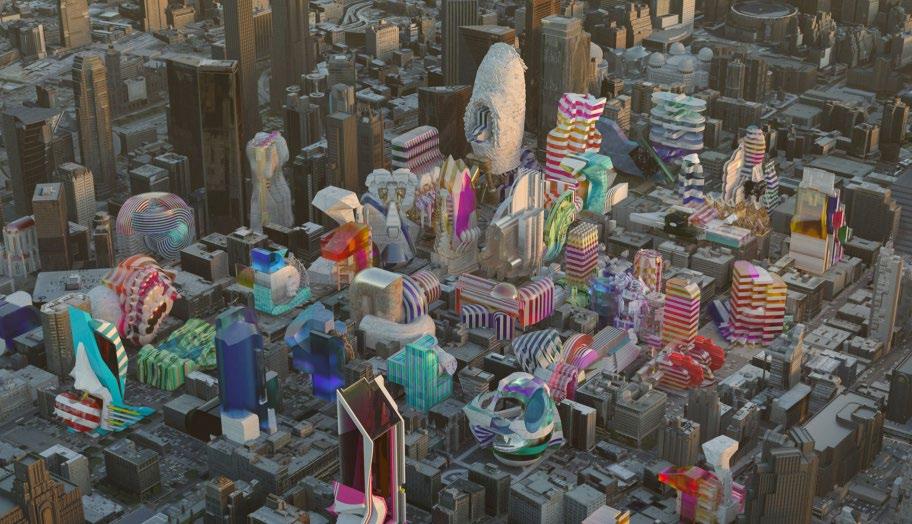
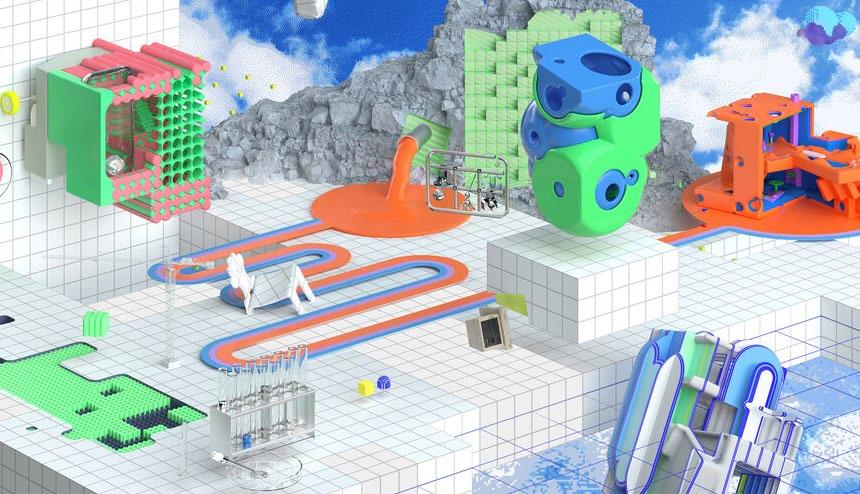
SOME USEFUL OBJECTS (PHYSICAL WORLD):
Chain-link fence: a wall, a separator.
Barbed Wire (Not used in its intended way)
Broken cement, traffic cones, old city infrastructure
Broken Glass
Diamonds or Gold: Hyper ‘valuable’ materials
Plastiglomerate
Political Hats or signs. blue red affiliations
Clothes, types of clothes
WAR, Bullets, Gun, Tanks
Car parts as materials, for a car-less world maybe
Asphalt broken up in big chunks or powders if roads are dismanted?
Expired Solar Panels as cladding
The parts of an old oil rig, the metal truss, showing optimistic progress of a world that has moved beyond oil
The tall structural-truss cranes that are used to build skyscrapers. used as a material and actual structure in a fictional reality that is post-skyscraper
The corpse of the skyscraper itself, and how that empty body can be inhabited, transformed, taken apart, etc. Do we exaggerate the death of the skyscraper, or do we clad it until it’s unrecognizable?
TVs, monitors, screens, LEDs, projectors. maybe put together to make a large-scale billboard, art display.
have potential.
- David Garcia.docx
SOME USEFUL OBJECTS (DIGITAL WORLD):
Dog, (My 2GAX project) or other animals / living things
Muscles, organics, blobous forms. Breathing forms.
Food and things that would quickly expire in the real world
Persona Object for an Identity House - materiality molded by their personality/ identity/ culture are. People could input info and have an architecture created by objects that give a feeling of “home” while in a virtual reality.
Water, Fire, Gas, etc. Elements that would be dangerous or difficult to tame in the real world could be used for aesthetic effect.
Memes as architectures. Designs made of the objects from the craze of meme cultures online.
ML/AI generated kit-bashing of pieces of speculative-architectures/landscapes/ concepts to create new speculations. Taking old aesthetic objects to make new.
Voting objects for a voting center, this could imply historical references, or could have some objects that are tropes of democratic institutions.
A Literal screen or a kind of display that shows events happening. We could digitally display a moving video, 3-dimensionally and/or 2-dimensionally on a screen, made from objects that create the form and space.
Screens or Signs on Body. If the architecture in cyberspace can tell stories, the people and their avatars should be able to express messages if needed.
Chat Logs, Hate Messages, Protest. Can ANY body modify a digital space? Should people be allowed to “graffiti” a building, how about destroying a digital building? Will those acts be completely absent because they won’t be programmed in? will we always find a way to protest the things we find wrong?
DIGESTIBLE MANIPULATED
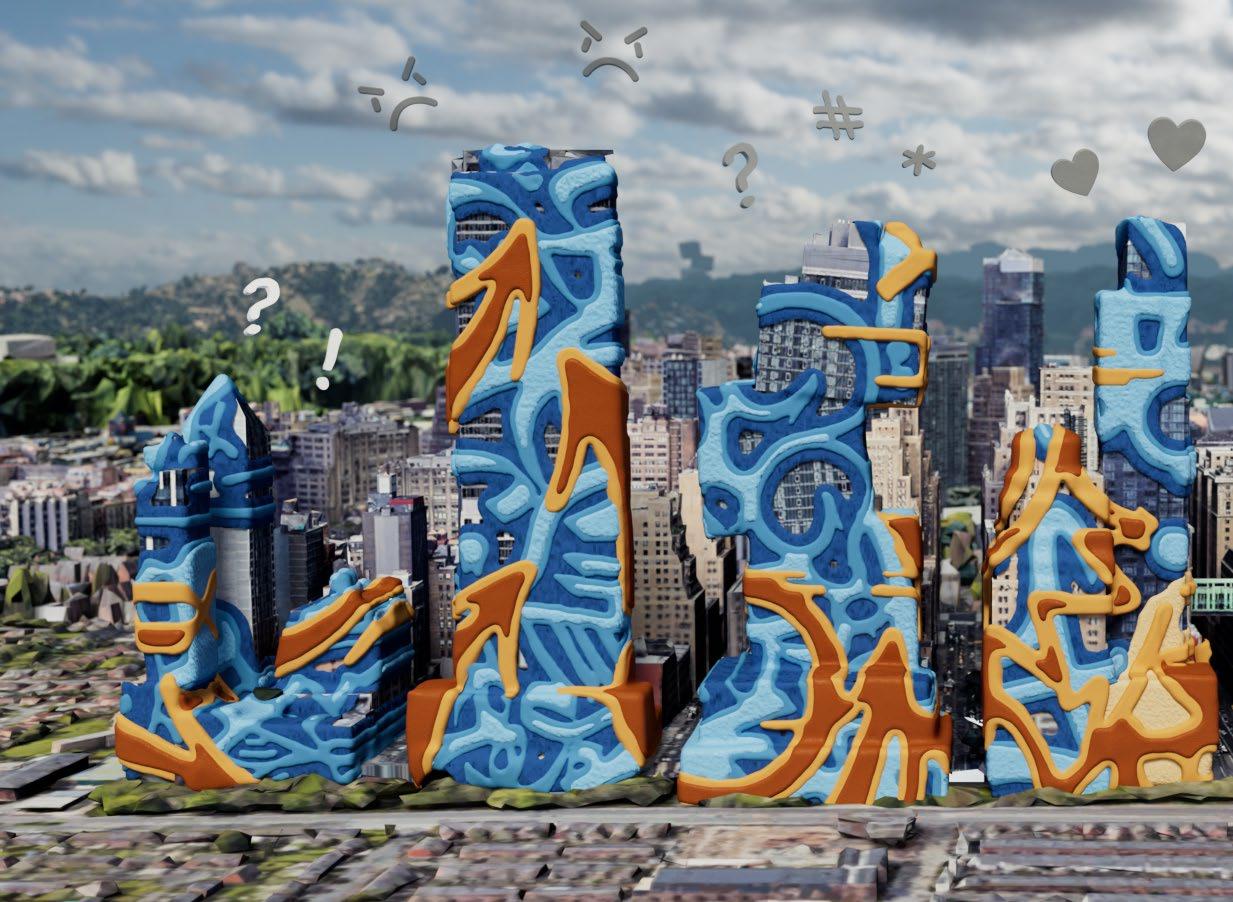
The project was a episodic animated series. Each episode was less than 3 minutes long, had zero spoken dialogue, with it's "characters" being inanimate buildings; it felt imperatave that every building-block that makes up this film add to the narrative. The design methodology
became about symbolism and aesthetics. Relaying complex narratives through visual aggregations of recognizable symbols (familiar objects/aesthetics that carry meaning, especially when paired or contrasted with other familiar objects). From the emoticon symbols, building-
MANIPULATED NARRATIVE OBJECTS
FInal renders / stills from the 3-Episode Microfilm
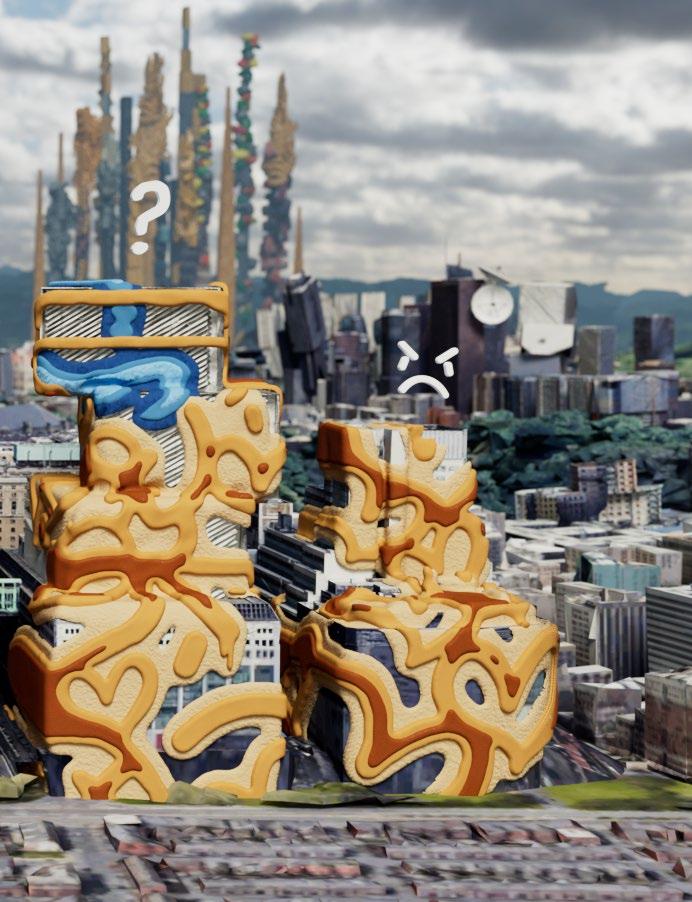
objects, and urban landscapes, to the colors, sound effects, and animation techniques; I attempt to tell a story without words. Which, one could say, is a fundamental role of architecture. This thinking then could allow my film to be accessible across language/age barriers.
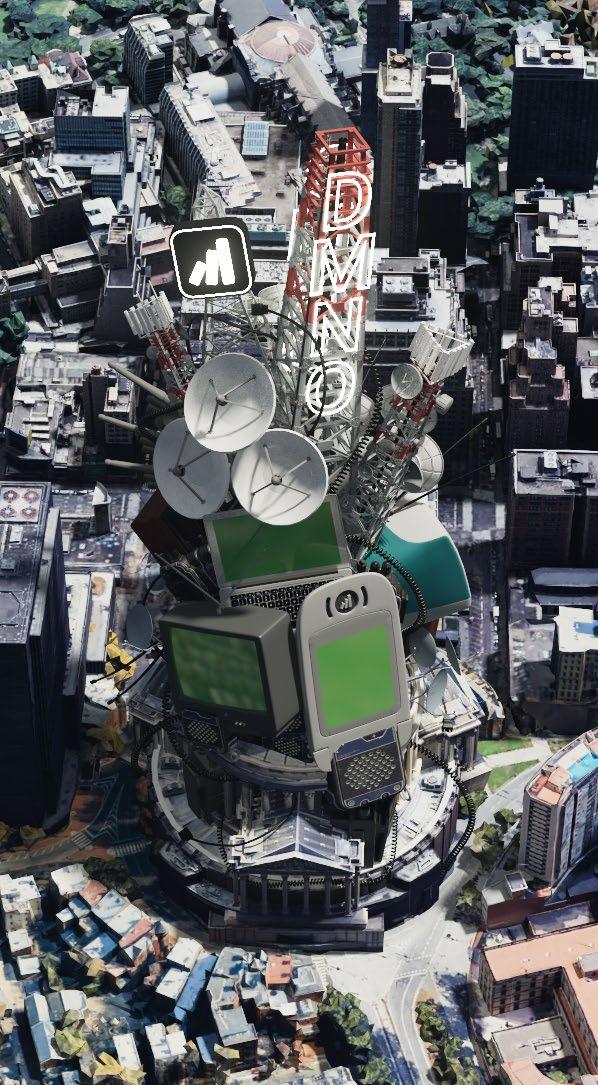
This is why I believe these strategies are worthwhile to study and share to the diverse audience I was given, at Sci-Arc Thesis. Whether a surreal fiction or a realworld built project, I think it's important to put care and intention into how and if your design communicates it's story.
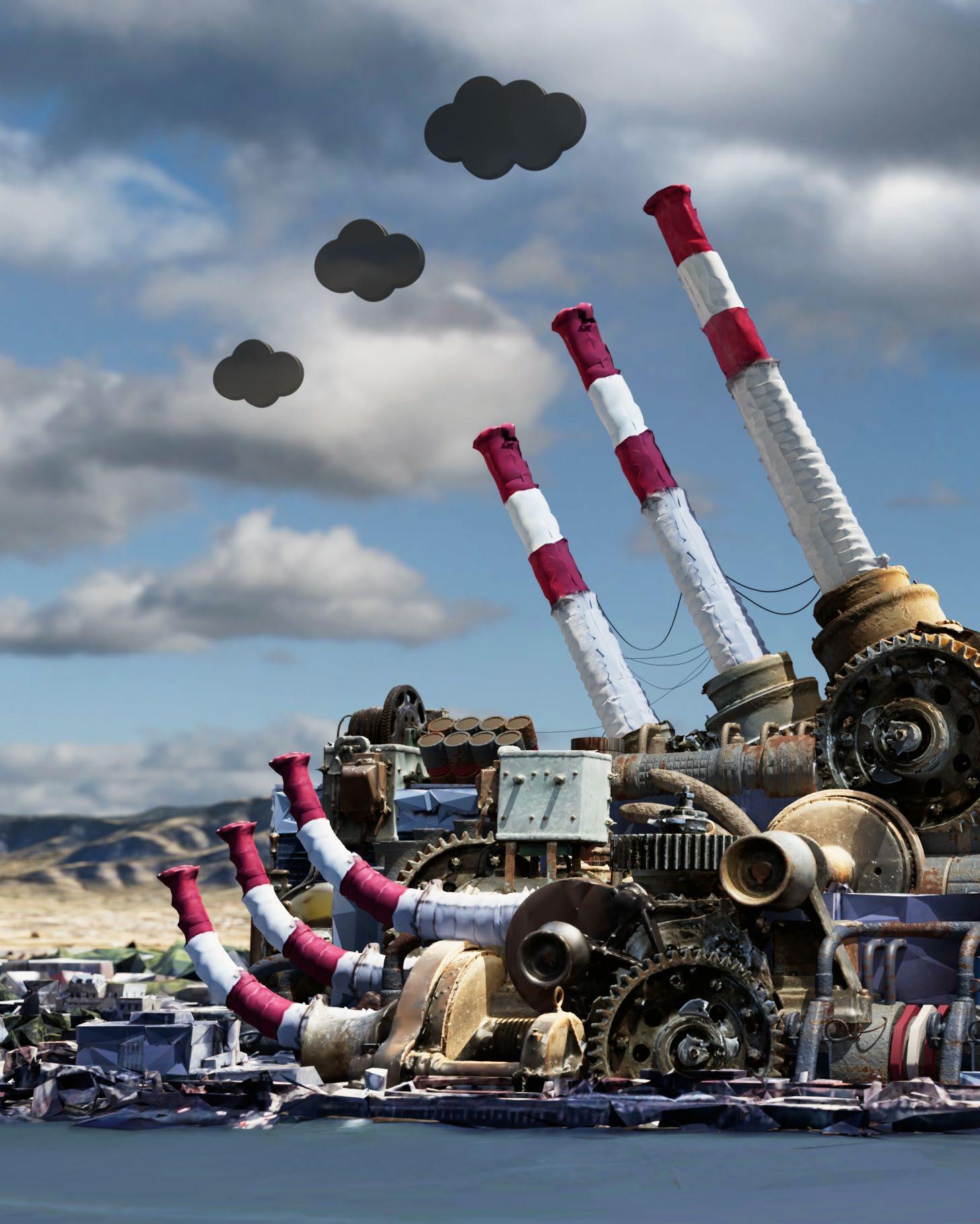
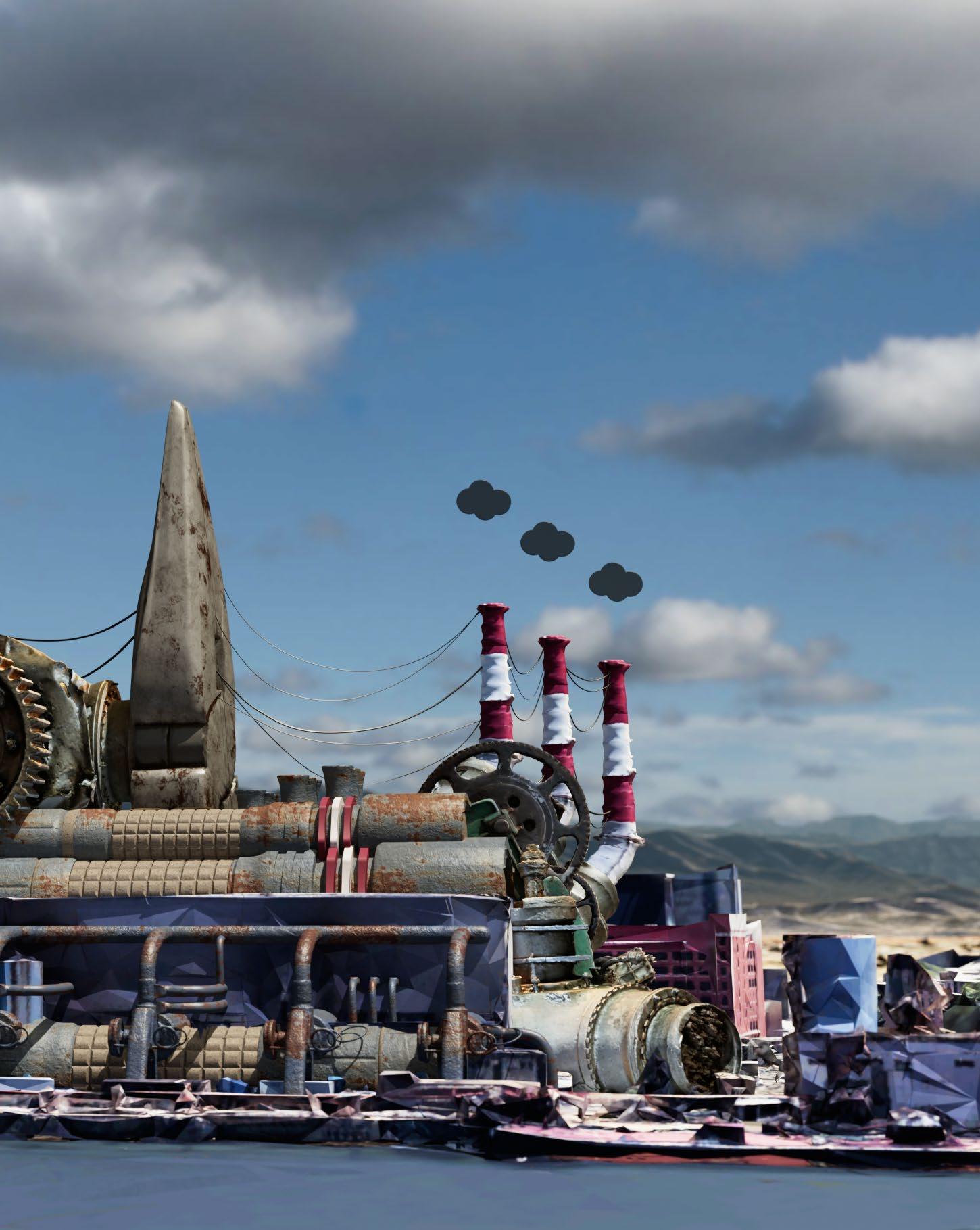
The Factory. One of the first buildings I designed for this world. (Not in film)
DIGESTIBLE: the red & white smokestack is a symbol If it was still unclear, giant rusty gears and pipes are Smaller / subtler detail-objects collaborate to establish

MANIPULATED: the smokestacks are rotated and curved in ways that are likely unrealistic, embedding curiosity and compositional beauty. Giant gears and pliers are transformed and assembled in a manner in which you can interpret them as the spire of some factory-cathedral rather than objects you would hold in your hands.
symbol synonymous with a 'factory'. are displayed explicitly, solidifying a factory aesthetic. establish the latent sense of "this is architecture".
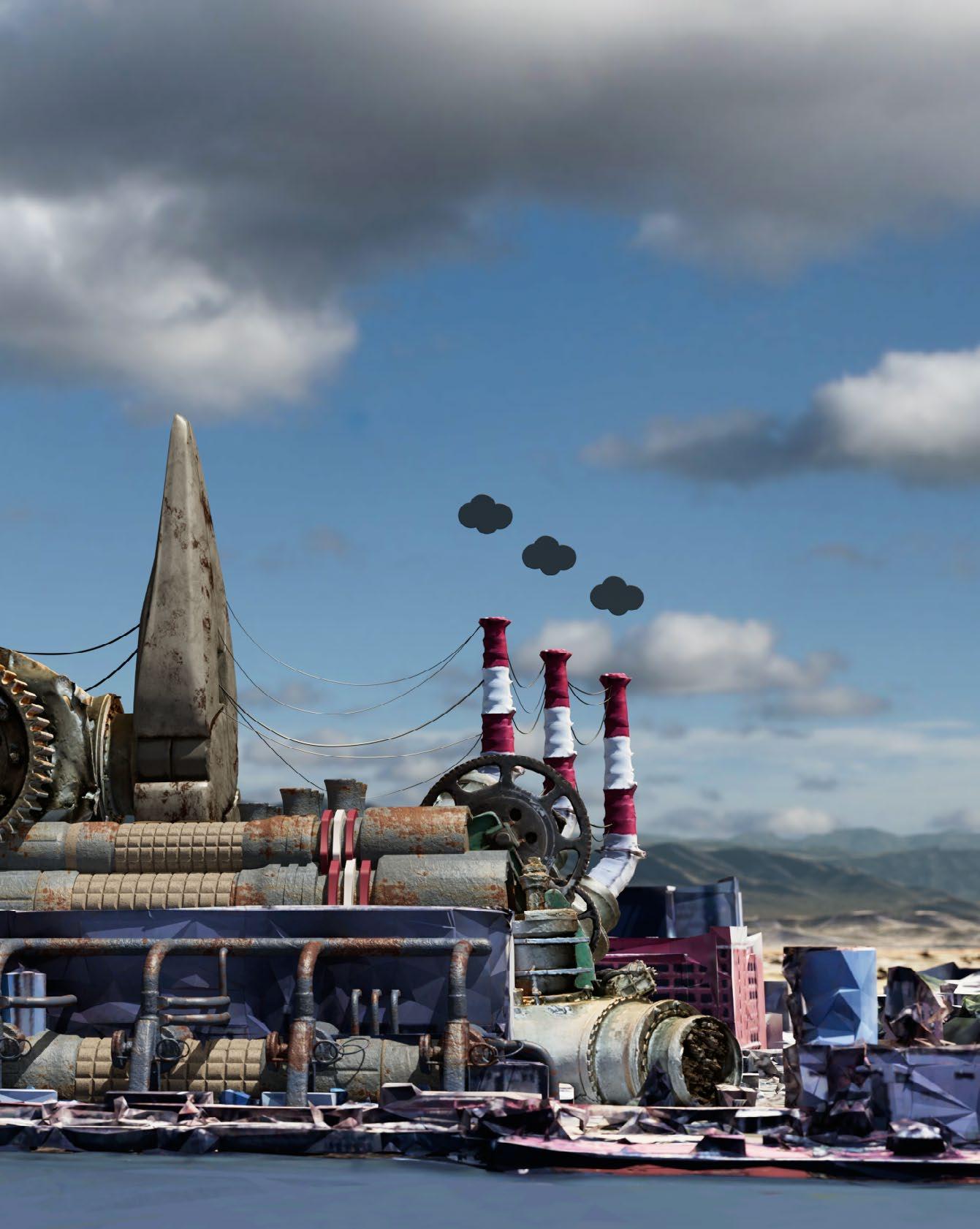
NARRATIVE OBJECT:
The objects/aesthetics in this design inform the audience on what to think. You don't know exactly what the building is for, but it's aesthetics convey that it is unappologetically industrial. To me, it reads off as some nefarious factory, void of nature. I now have preconceived assumptions on the actions and motivations this 'character' would have. The aesthetics embedded a storyline. *BREAKDOWN*

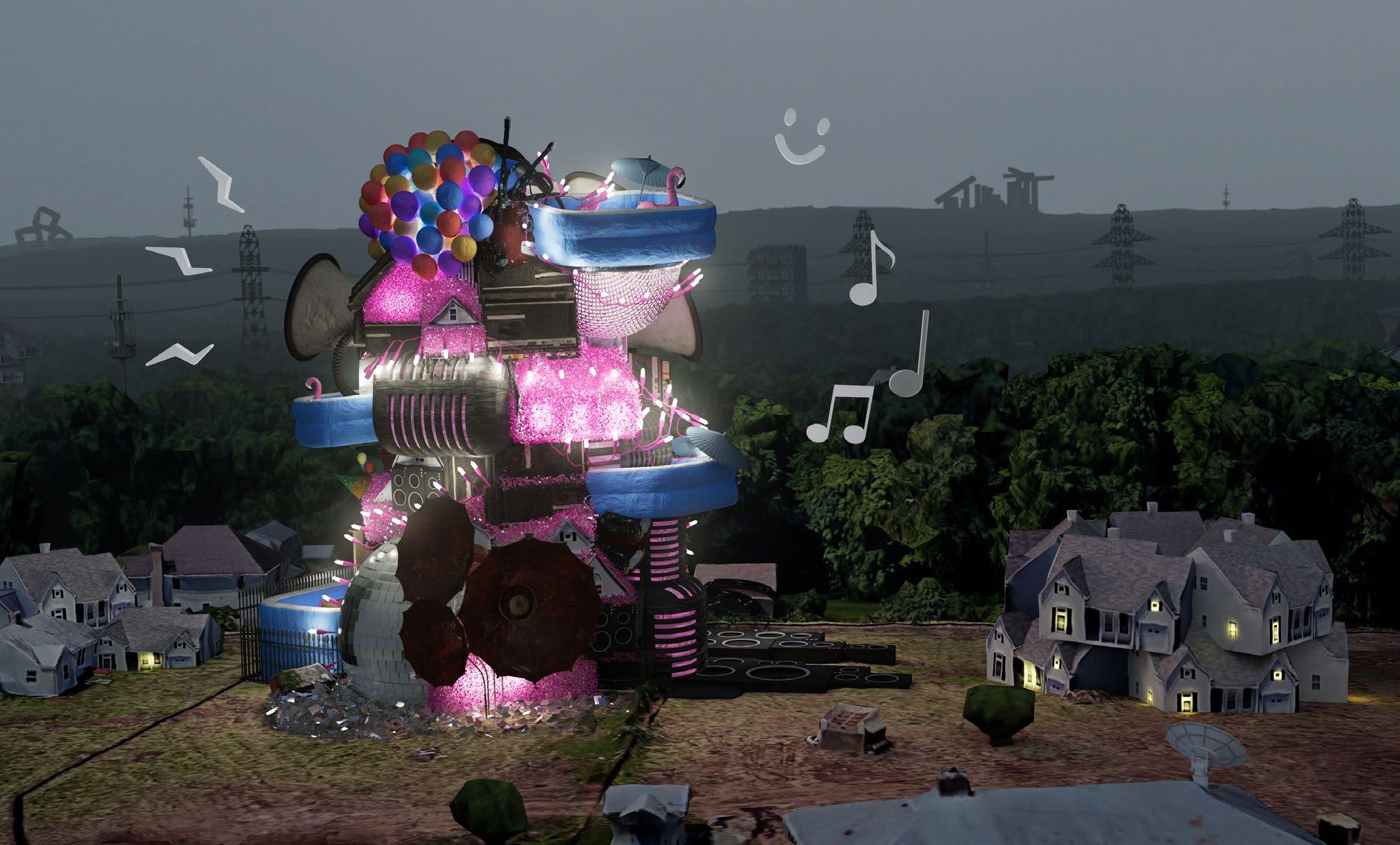
HOUSE PARTY
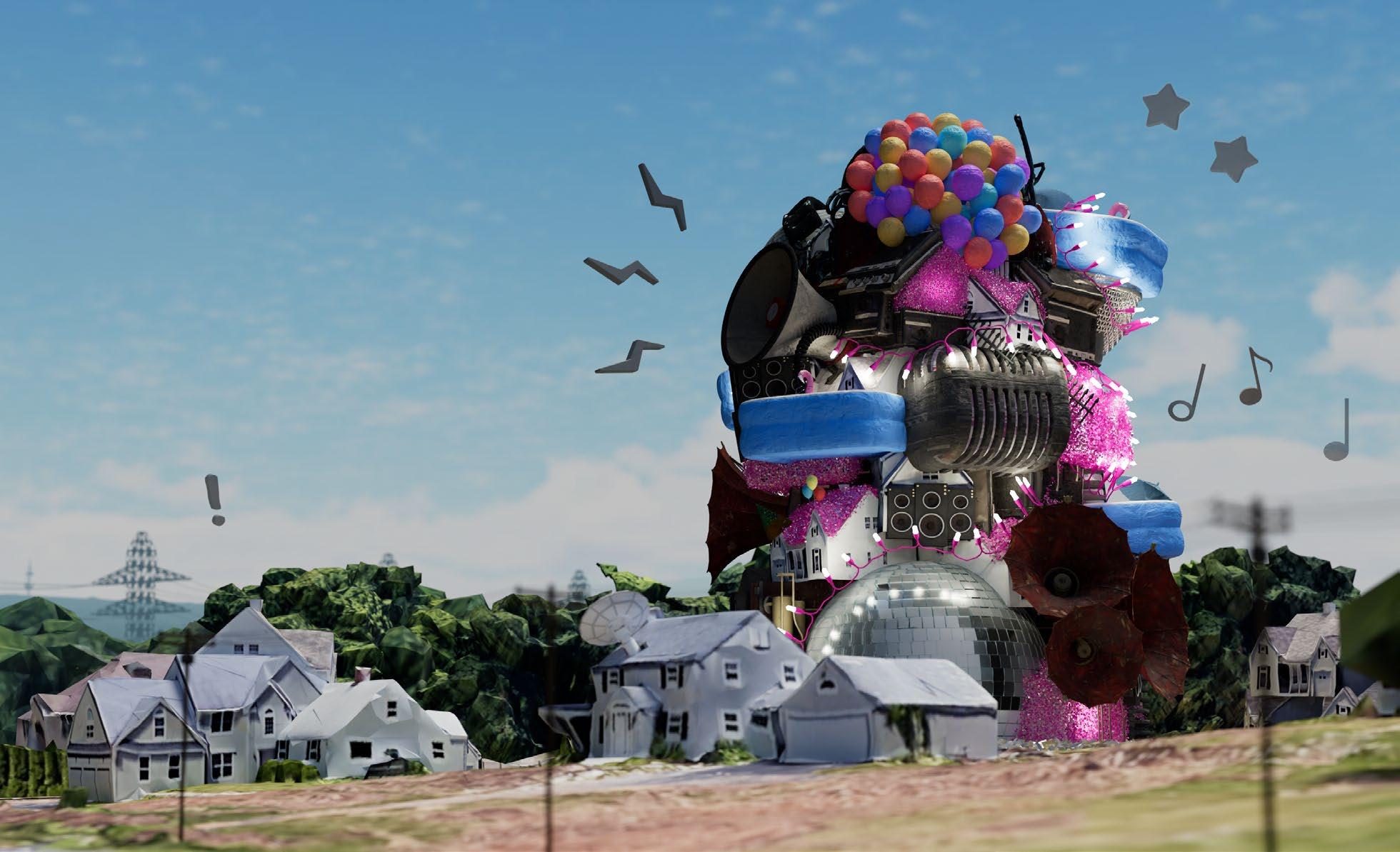
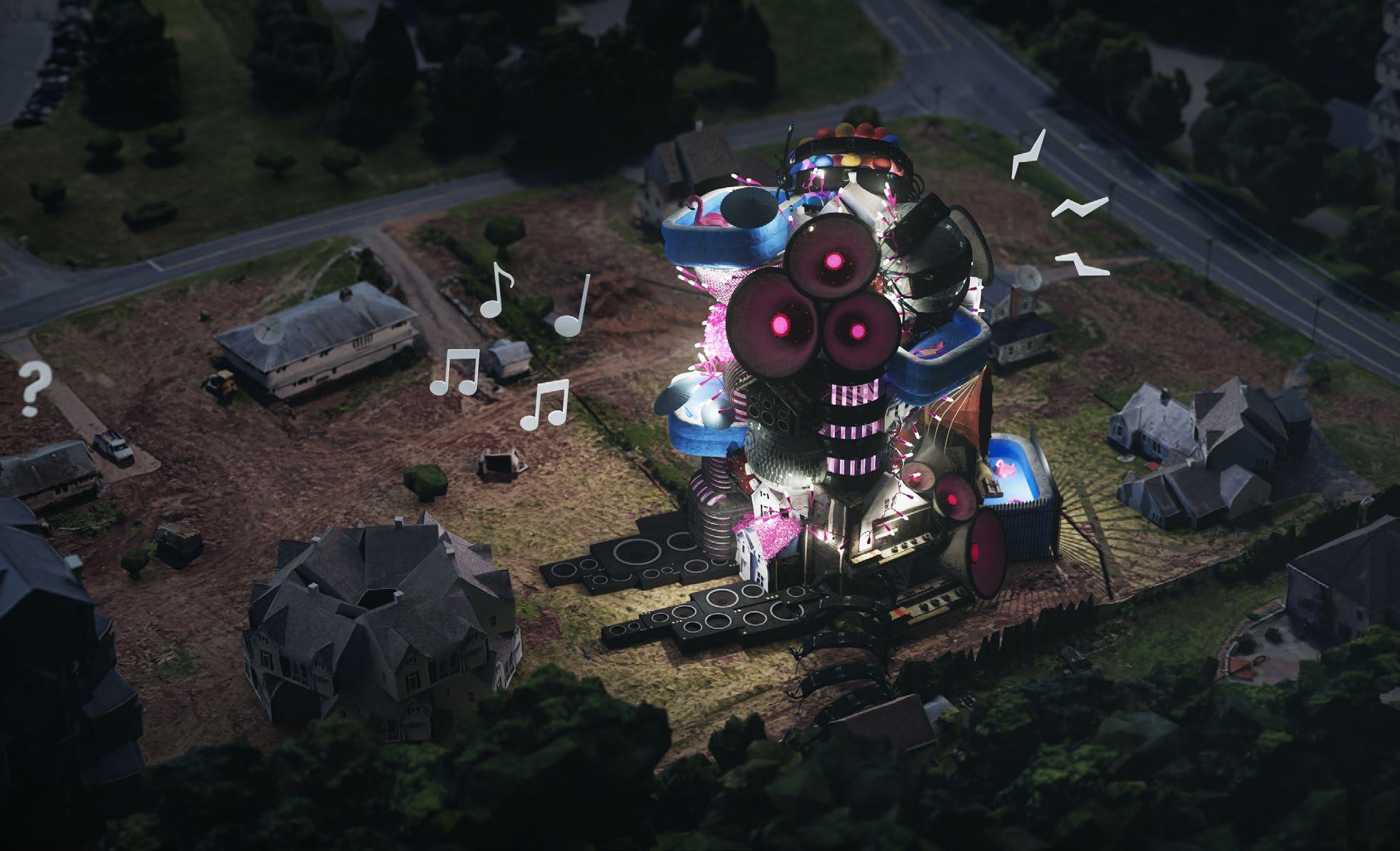

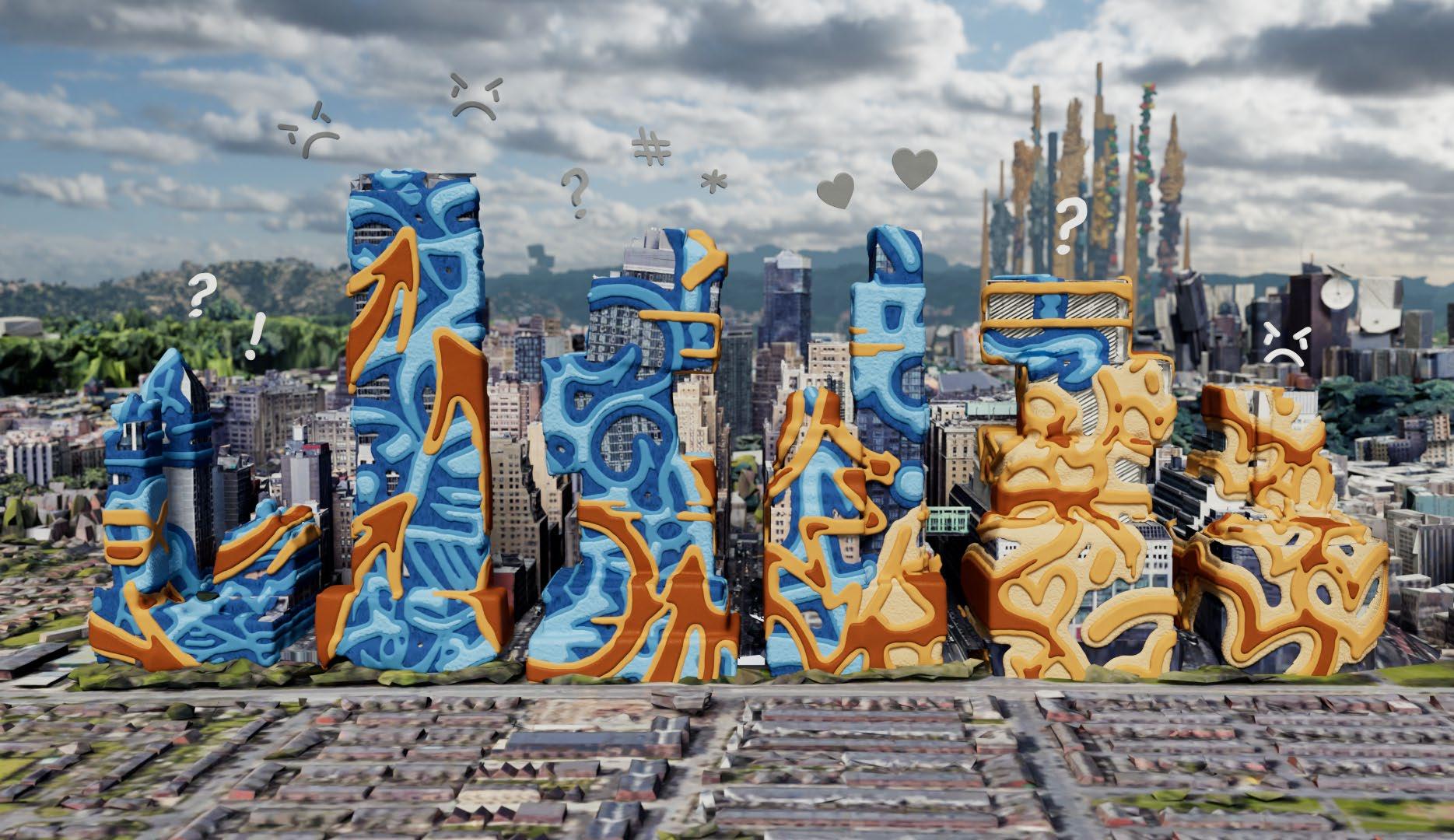

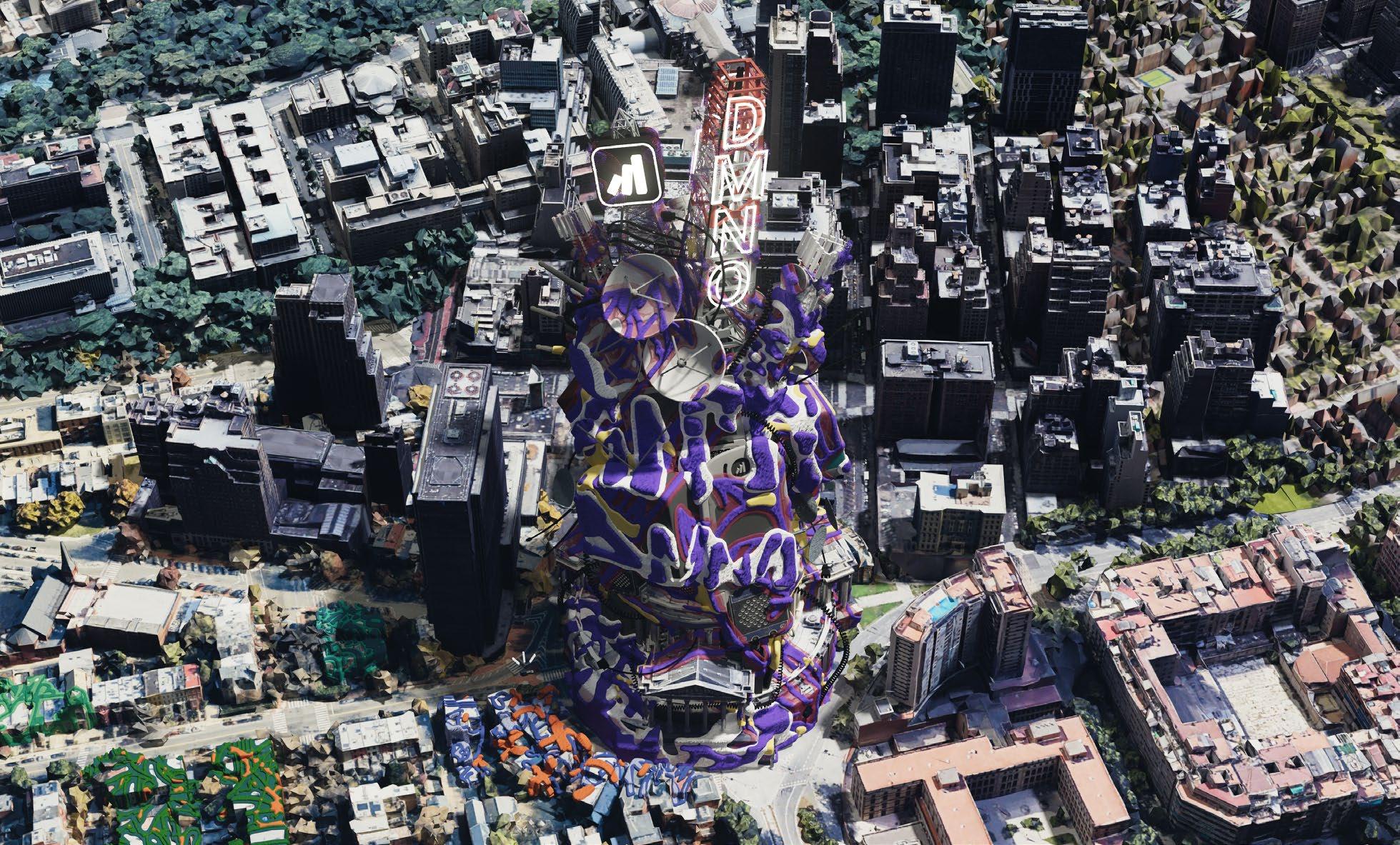
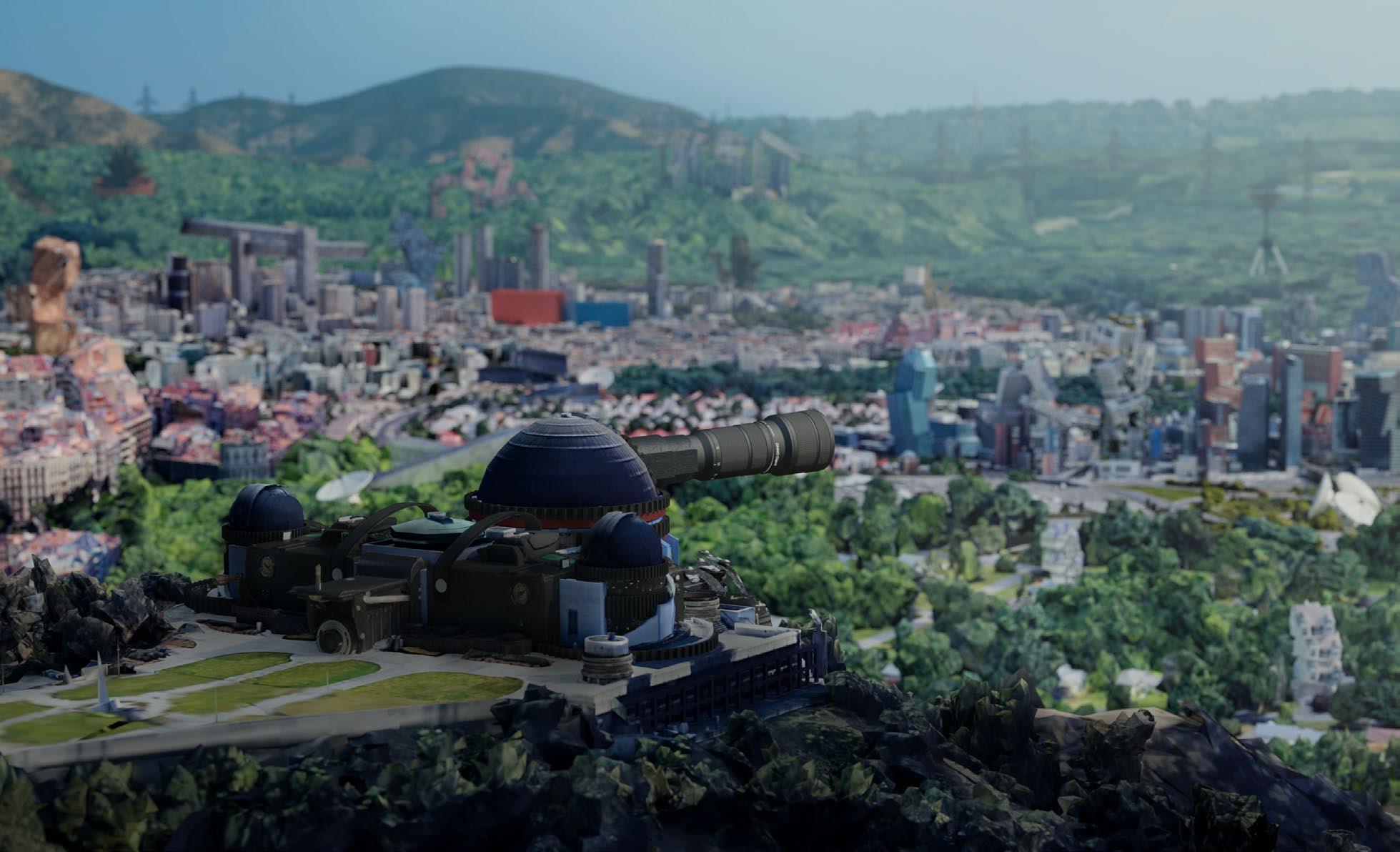
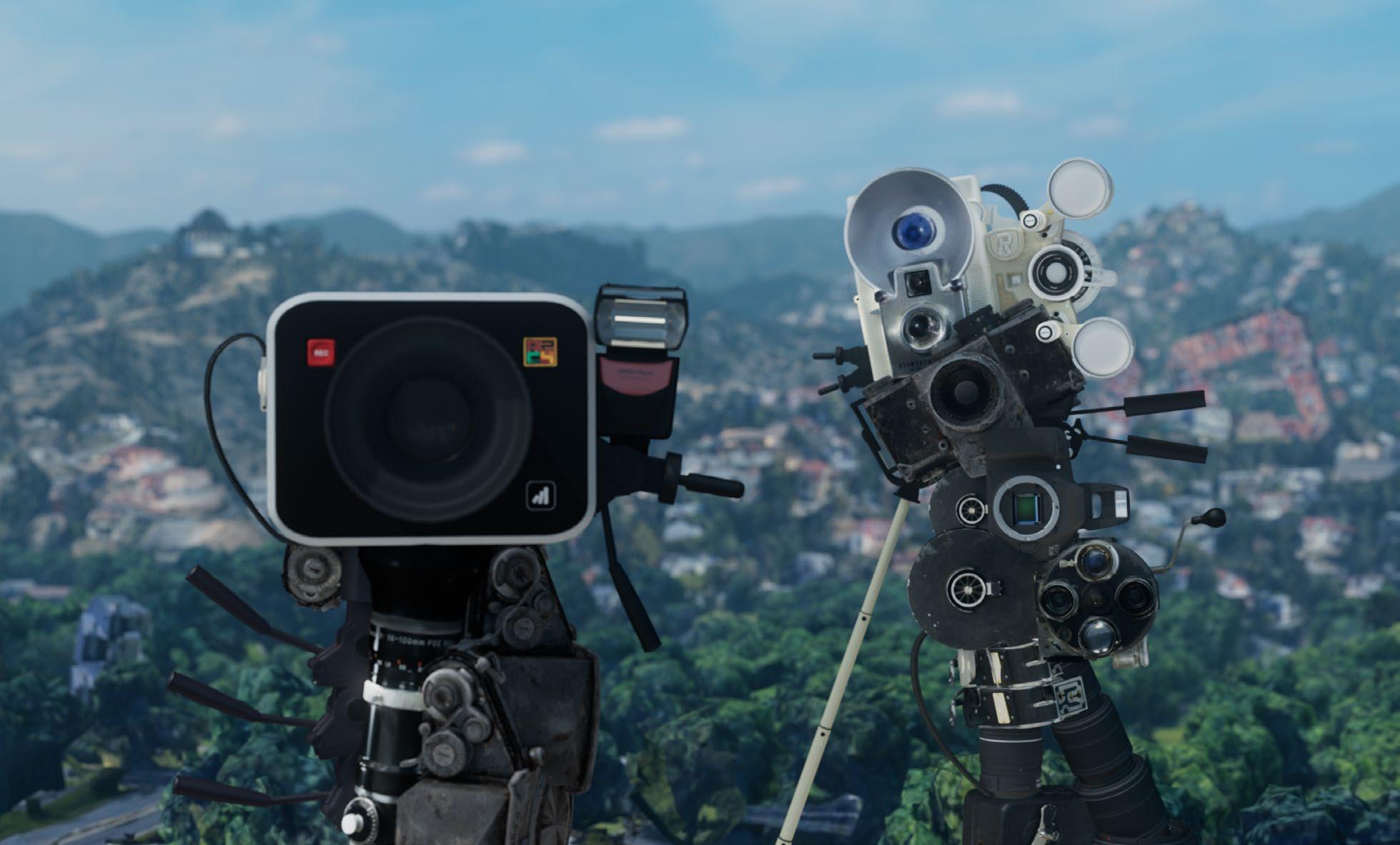
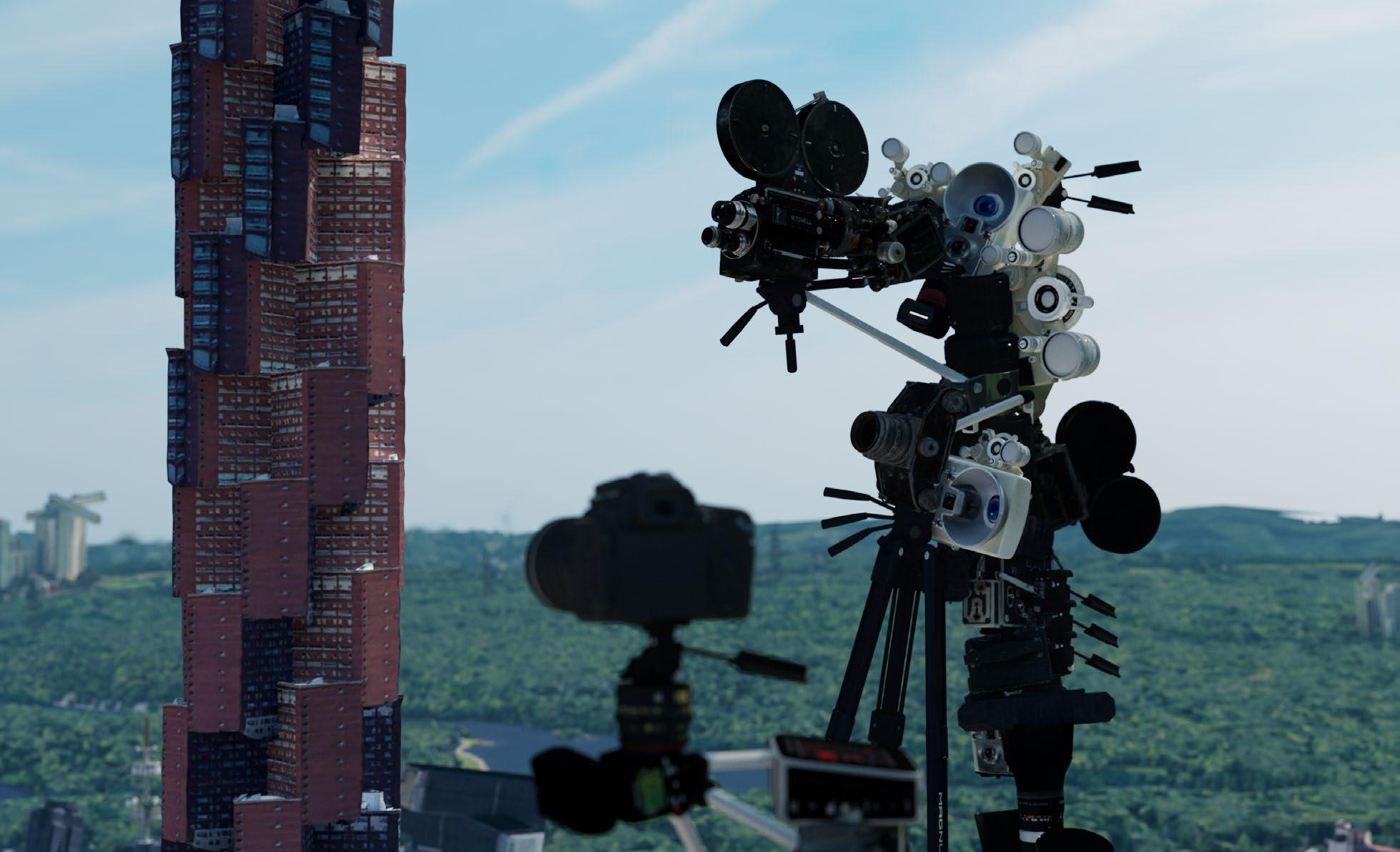
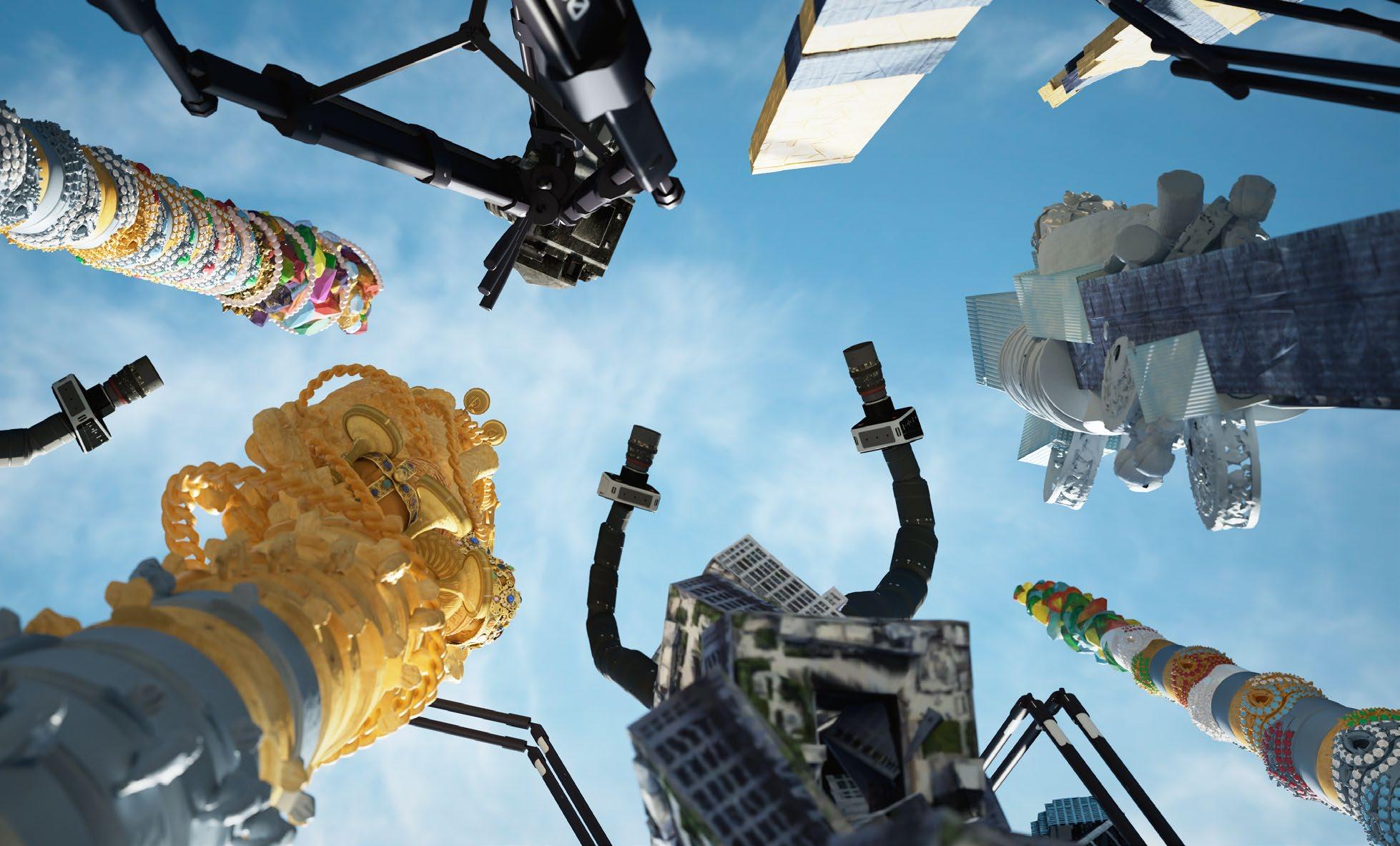
NARRATIVE OBJECTS: Camera, Old-school Film Equipment, Tripods, Lens, Eyes Watching You, Tentacle Forms, Spider-ish Forms, Black/White Color, Overwhelming Quantities
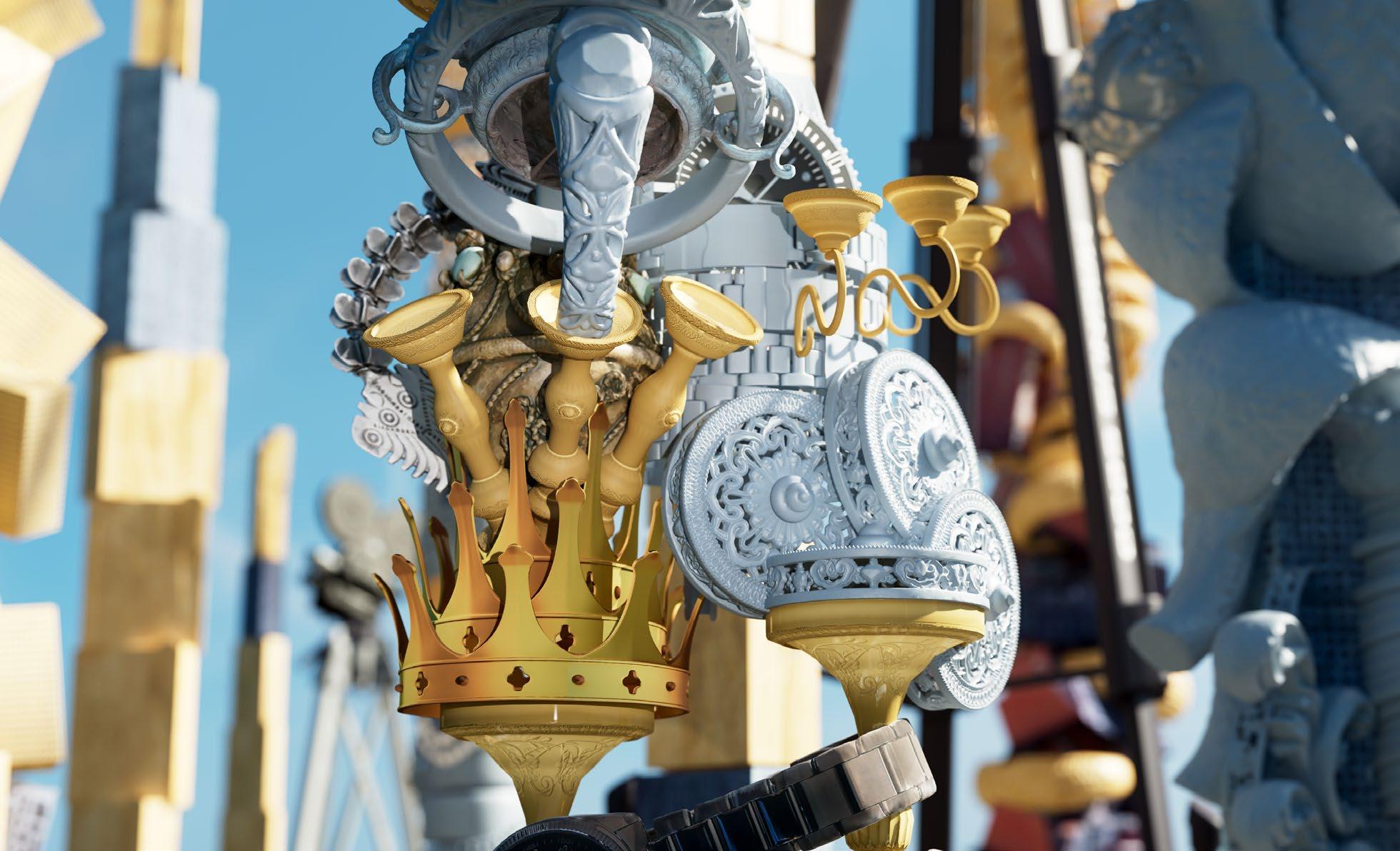
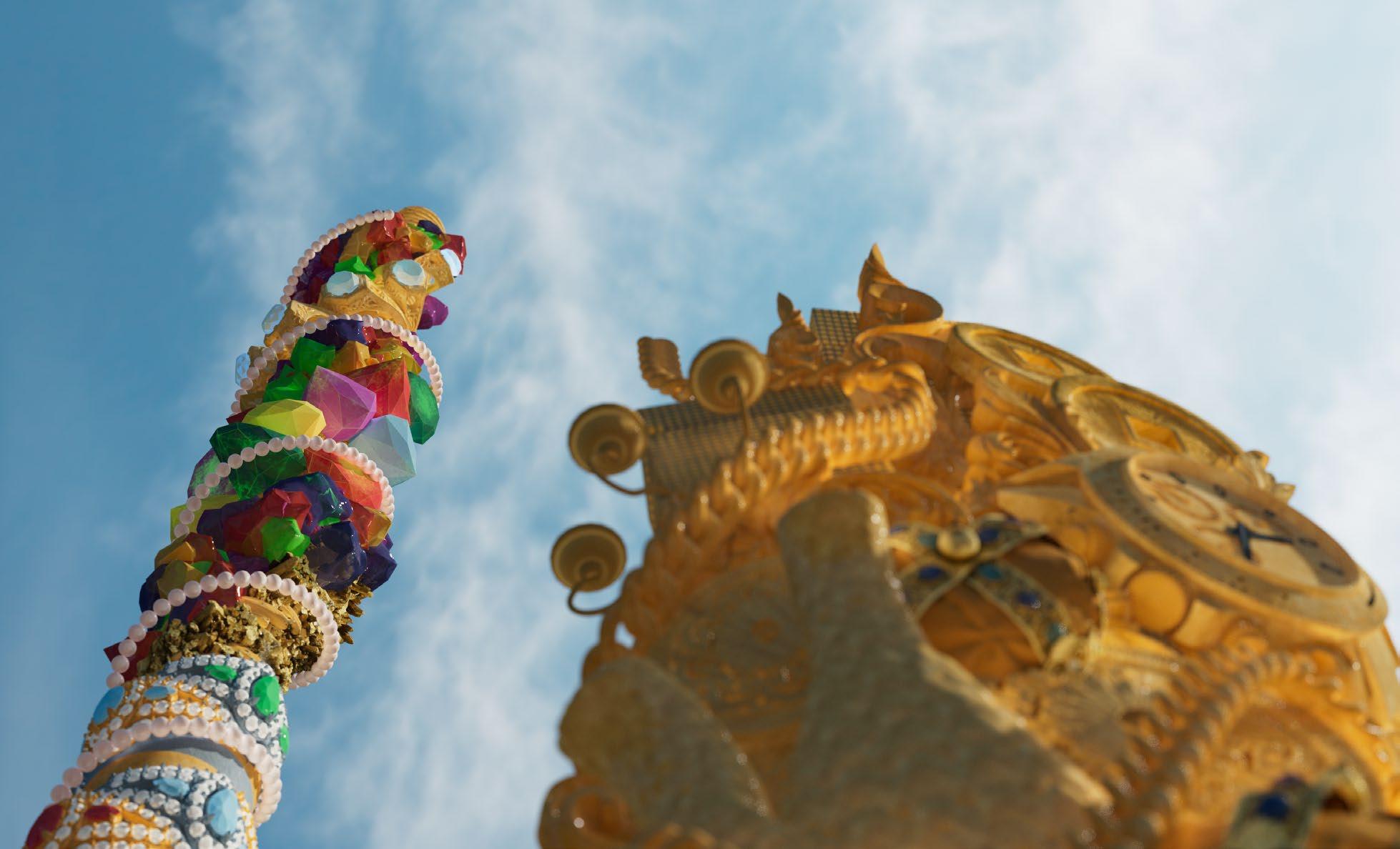
ATTENTION SEEKERS ?

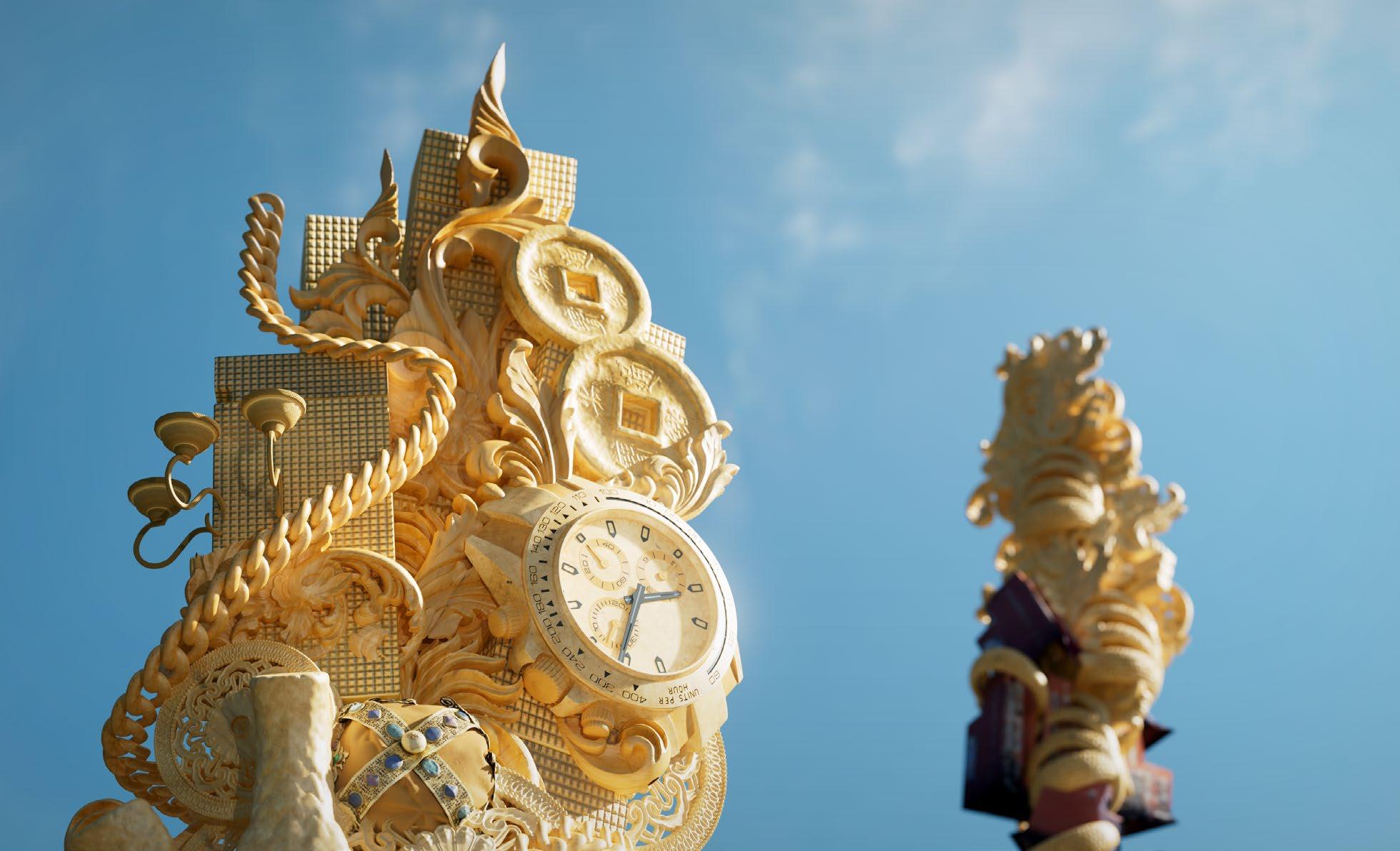
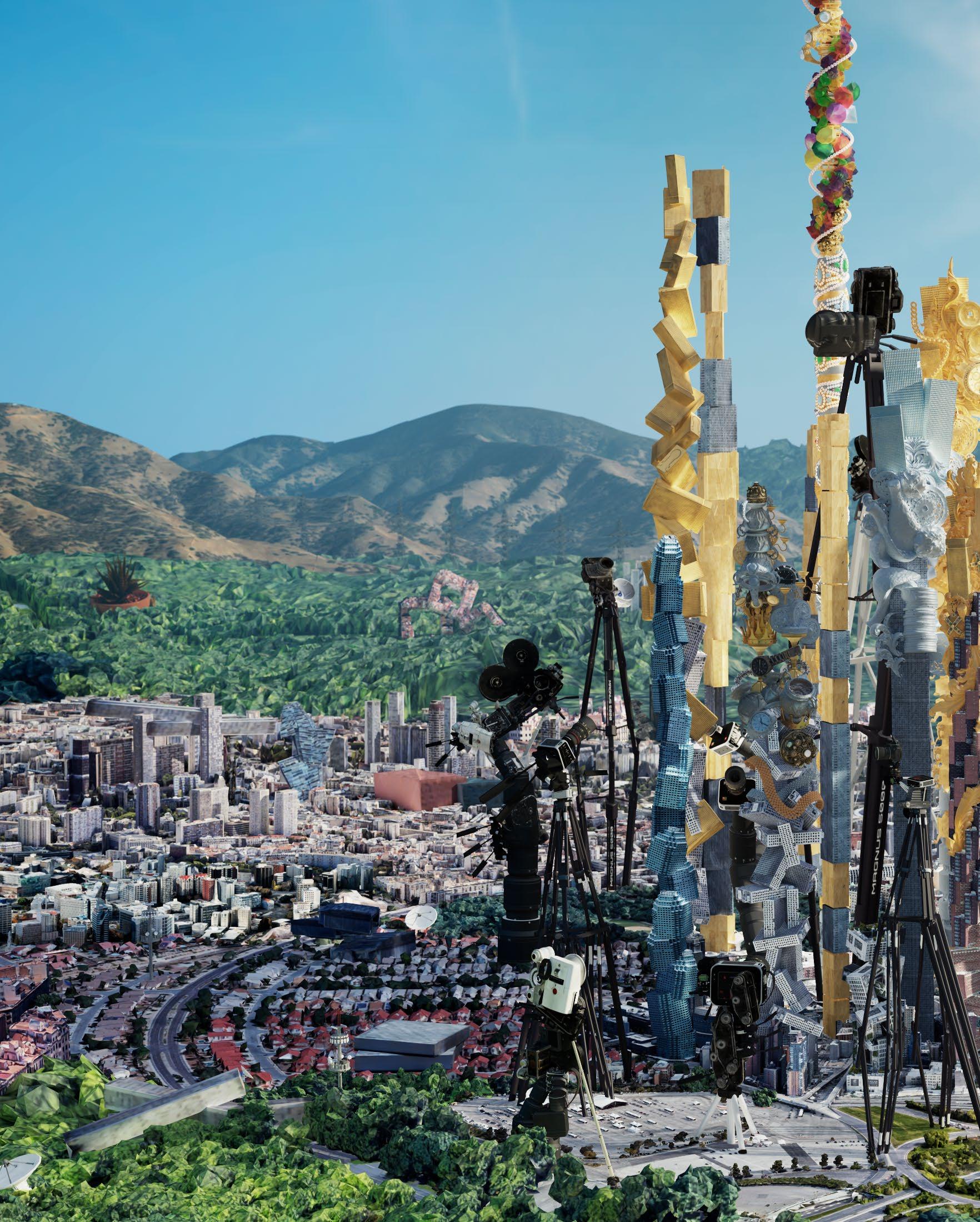

Paparazzi Shadow Tower. One of the closing shots of episode 02.
That'll conclude the Design Methodology portion of the my research. Now, onto the film itself.
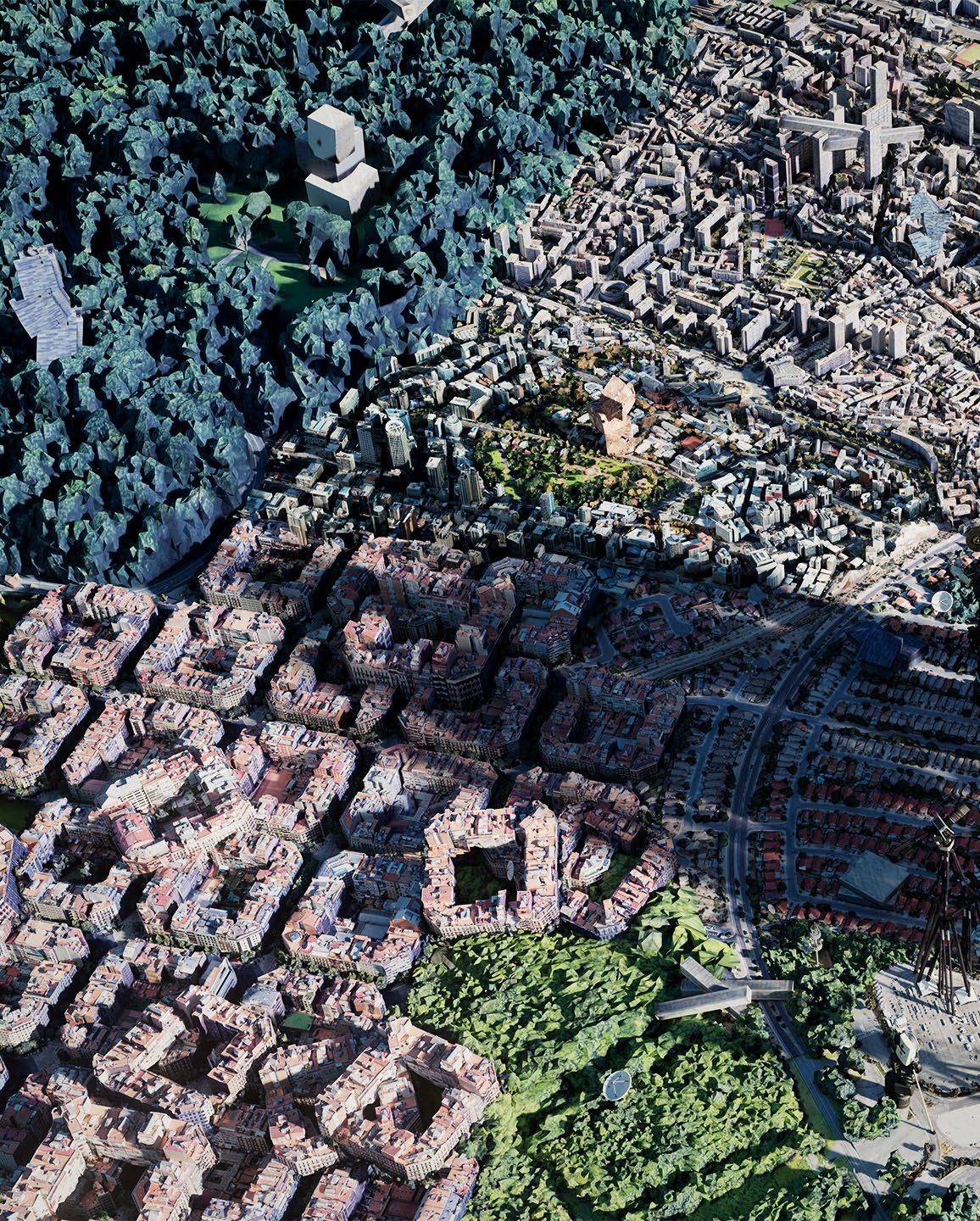



Click or scan if you would like to watch the full microfilm.
(5min. total, 3 episodes)
Read the next chapter posted on my issuu account, where I explain the narratives and my thought process behind the world.
2025 EDIT 2025 EDIT
Thank you for reading.
David A Garcia

